

The engineers are looking at options to enhance the performance and the aesthetics of the vehicle in order to increase sales. This development will consume a lot of resource and time and as a result both the positive and negative sides of the deal need to be determined before heading on with the project. Like the current version of the Veyron Super Sport, the next generation vehicle will also be composed of a carbon fiber exterior on a lightweight aluminum chassis.
This is expected to reduce the weight of the vehicle by about 200 kg, a massive improvement considering the already low weight of the vehicle. Power to weight ratio will be enhanced by a huge margin which will result in massive acceleration and top speed. Although the mechanical or technical specifications have not been revealed, this vehicle is expected to be a mammoth in terms of performance.
It is expected that Bugatti will install a 1500 BHP displacing W16 engine under the hood although a hybrid technology is not likely to be accompanied with the primary engine. Bugatti is expecting a top speed of 280 MPH although this factor is completely dependent on the ability of the tires.
The current model of the Veyron Super Sport reaches a top speed of 267.82 MPH and as a result Bugatti is claiming the mentioned top speed to stay at the safe side. The asking price is pretty huge and the company will have to deliver if they want customers to shell out the extra millions for the added performance. Interior or exterior details are yet to be unveiled although renderings of this vehicle should be available by year end.
Source: unknown. Thus news, or only a rumour??
 December 15, 2013
December 15, 2013 Anyone with a Bugatti Veyron on their list of holiday season gifts be warned: only 50 examples of the multi-million dollar hypercar are left and when the final one is sold, production will cease forever.
And with the end of the 450-model production run will come the end of one of the most remarkable chapters in automotive history.
A car born out of an obsession to create the fastest, most luxurious and most exclusive supercar in history, it was the first production car with over 1000bhp, the first to go from 0-100kph in 2.45 seconds and to this day is still the fastest proven street-legal vehicle in existence -- capable of 431kph or 267.8mph. And then there's the price tag, a whopping $1.3 million (€1.2 million) for the ‘entry level' EB 16.4.
Yet despite the price, which has climbed significantly as horsepower and top speed have increased in the face of competition, all of the hardtop coupe editions (limited to 300 examples) have found caring owners, as have 100 open-top roadsters, and Bugatti is this week celebrating the sale of the 400th Veyron to a client in the Middle East -- a €2.13 million ($2.9 million) Grand Sport Vitesse ‘Jean-Pierre Wimille' special edition, which itself is limited to three examples.
Of hitting this milestone, Dr. Wolfgang Schreiber, President of Bugatti Automobiles, said: "With the Veyron, Bugatti has established itself as the most exclusive and most luxurious super sports car brand in the world. The Veyron is a unique success story and sets a high standard for the future of Bugatti."
And that's no exaggeration. The Veyron could prove an impossible act to follow, although that won't stop Bugatti from trying. But as well as replacing the Veyron, the Volkswagen-owned company is also expected to launch an equally sporty executive car that will give the Rolls-Royce Wraith, Bentley Continental Flying Spur or even the Ferrari FF a run for their money.
Though this sounds all very great, sales are gradually decreasing, with only 16 sold in the first half of 2013. Ed.
 November 6, 2013
November 6, 2013 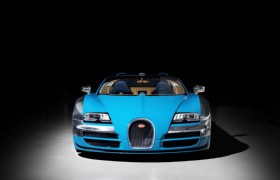
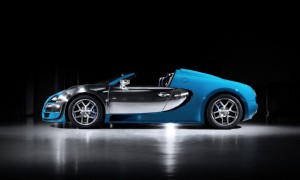
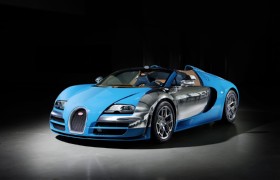

Bugatti is presenting the third model in its six-part edition “Les Légendes de Bugatti” at this year’s Dubai International Motor Show (November 5–9). This Legend car, which like all cars in the series is based on the Veyron 16.4 Grand Sport Vitesse, pays homage to Meo Costantini. Costantini was a close friend of the company’s founder, Ettore Bugatti. He was the head of Bugatti’s factory race team for many years and was also a driver, winning the Targa Florio two times in the Bugatti Type 35, one of the most successful racing cars of all time. The Legend Edition “Meo Costantini” is priced at €2.09 million, excluding taxes and transport. As with all Bugatti Legend cars, the production run is limited to only three vehicles.
“Meo Costantini embodies the most successful era in Bugatti’s racing history,” says Dr Wolfgang Schreiber, President of Bugatti Automobiles S.A.S. “Ettore Bugatti’s vehicles from the 1920s stand for light-weight construction and technical aesthetics. When Bugatti created the Type 35, he inspired one of the most successful racing cars of all time. The Vitesse ‘Meo Costantini’ is reminiscent of the Type 35.”
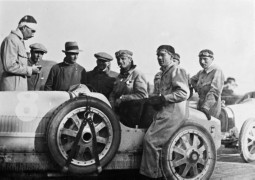 Bartolomeo “Meo” Costantini, born in 1889, was the head of Bugatti’s racing team for eight years. He developed an interest in racing cars and began racing at an early age. It was after the First World War that he first came into contact with the Bugatti brand, when he was involved in modifying a Bugatti Type 13. This is the car that Meo would drive during his first races in 1920-21. It was through these races that Ettore Bugatti first became aware of the young Italian’s talents, and he invited him to Molsheim in 1923. The two developed a close bond, and Costantini worked for Bugatti as a racing driver and advisor from that time on. As a member of the factory team in 1925 and 1926, he won the most famous and important race in its time, the Targa Florio in Sicily (The photo is from the 1925 Targa Florio). In 1926, he also drove to victory at the Spanish Grand Prix and the Grand Prix of Milan, and took second place in Monza. Shortly afterwards he ended his active racing career in order to manage the Bugatti racing team, a post which he held from 1927 until 1935. Costantini stayed at Bugatti until 1937.
Bartolomeo “Meo” Costantini, born in 1889, was the head of Bugatti’s racing team for eight years. He developed an interest in racing cars and began racing at an early age. It was after the First World War that he first came into contact with the Bugatti brand, when he was involved in modifying a Bugatti Type 13. This is the car that Meo would drive during his first races in 1920-21. It was through these races that Ettore Bugatti first became aware of the young Italian’s talents, and he invited him to Molsheim in 1923. The two developed a close bond, and Costantini worked for Bugatti as a racing driver and advisor from that time on. As a member of the factory team in 1925 and 1926, he won the most famous and important race in its time, the Targa Florio in Sicily (The photo is from the 1925 Targa Florio). In 1926, he also drove to victory at the Spanish Grand Prix and the Grand Prix of Milan, and took second place in Monza. Shortly afterwards he ended his active racing career in order to manage the Bugatti racing team, a post which he held from 1927 until 1935. Costantini stayed at Bugatti until 1937.
Bugatti Legend Car “Meo Costantini”
The series of Bugatti Legend cars, “Les Légendes de Bugatti”, was launched in August at California’s Pebble Beach Concours d’Elegance with the Vitesse “Jean-Pierre Wimille”. This was followed by the Legend car, “Jean Bugatti”, which was presented at the International Motor Show in Frankfurt. Now, the third Legend Edition, dedicated to Meo Costantini, will be revealed to the public for the first time in Dubai.
The car is based on the Bugatti Veyron 16.4 Grand Sport Vitesse. Its 8-liter W16 engine achieves an unparalleled torque of 1,500 Nm from 1,200 hp at 3,000–5,000 rpm, and can accelerate from 0–100 km (0 to 62 MPH) in 2.6 seconds. The Vitesse was driven to a top speed of 408.84 km (253 MPH) with the roof down in April 2013, making it the fastest production roadster ever built.
Design
Exterior. The body of the Vitesse Legend “Meo Costantini” is primarily constructed of carbon fiber. The wings, doors, the parts behind the doors, the “medaillons” (French) and corners of the front bumper are rendered in aluminium. The blue paintwork on the carbon fiber parts references France’s classic motor sport color, as well as the Type 35. The new paint color “Bugatti Dark Blue Sport” has been specially developed for the vehicle. The aluminium parts are hand-polished and coated with clear lacquer. Bugatti is the only production manufacturer to offer polished clear-coated aluminium bodywork. Another special feature of this car is that individual parts have two different paint finishes. This requires great skill, and is particularly impressive to see on the wings, which are finished in both clear lacquer and blue paint.
As a reference to Costantini’s victory at Targa Florio, the silhouette of the historic race course is painted on the underside of the rear wing (air-brake) in “Bugatti Dark Blue Sport.” Another feature that pays tribute to the illustrious racing driver is his signature, which is laser-engraved into the aluminium tank and oil caps and painted in silver.
Interior.
The interior of the Legend Vitesse “Meo Costantini” is completely upholstered in leather. The roof, footwell, center sections of the seats and rear wall are all in the color “Gaucho”, a sophisticated cognac tone. The seat’s side cushions, arm rests, extended center console, door panels, dash panel, instrument panel and steering wheel are all trimmed in dark blue leather in the “Lake Blue” color. The decorative stitching in contrasting light blue (“Bugatti Light Blue Sport”) lends an expressive touch.
A brief glance into the interior makes it immediately clear to whom the car is dedicated. The head restraints are embroidered with Meo Costantini’s signature in “Bugatti Light Blue Sport,” whilst the cover of the rear center box features the eye-catching silhouette of the Targa Florio race route. The silhouette is portrayed in a milled and polished aluminium relief that has been attached directly below the EB logo on the cover, itself crafted from dark blue clear-coated carbon fiber.
A special highlight of the interior is the racing scenes and vintage car motifs on the doors, which have been laser-engraved into the leather trim with the utmost precision and attention to detail. These images illustrate the most glorious moments of Meo Costantini’s racing career and the exciting world of motor racing in the 1920s. The interior trim of the door pockets and door handle recesses in “Bugatti Light Blue Sport” adds a dash of color.
The Vitesse Legend “Meo Costantini” also shares several features with the other Legend cars in the Edition, including the inlay in the extended section of the center console, crafted of clear-coated carbon fiber and sporting the Legend logo with the famous Bugatti elephant, and the door sill strips displaying the likeness and signature of Meo Costantini.
Bugatti Type 35: One of the most successful racing cars of all time.
The Bugatti Type 35 numbers among the brand’s most outstanding vehicles. With more than 2,000 victories, this is one of the most successful racing cars in motorsports history. In line with the motto “Race on Sunday, sell on Monday”, the Type 35 brought a golden era to the Molsheim-based company, with Ettore Bugatti selling many Type 35s directly to wealthy racing drivers directly after the races. In its time, the Type 35 was the only car that could be driven both on the race track and on public roads.
Meo Costantini achieved almost all of his victories in a Type 35. The racing car draws its power of approximately 100 hp from a 2-liter, straight eight engine. Its weight of 750 kg including the body is distributed perfectly across the axles (50 to 50 percent), giving the car incredible manoeuvrability. With its characteristic racing car body in tear-drop shape, this is a car that continues to capture the imagination right up to the present day.
The Dubai International Motor Show takes place on Nov 5 -9, 2013 at the Dubai World Trade Centre. The Bugatti exhibit is in Sheik Saeed Hall 1.
Well; the comment is the same as with the former "Legende de Bugatti", not really something new, just a ver well made car, with some drawings on it to connect it to the original Bugatti history. Ed.
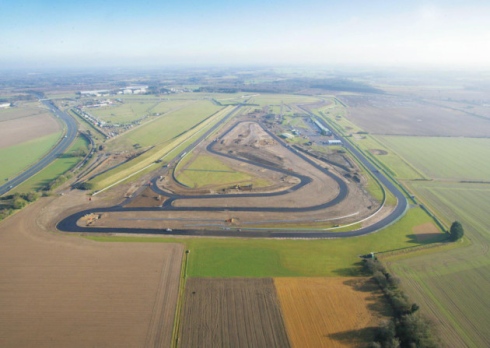 October 2, 2013
October 2, 2013 Stephen Jewell, 63, was in a 1924 Bugatti T35B when it crashed at Snetterton Circuit on Sunday, the Motor Sports Association (MSA) said. There was contact (causing the accident or caused by the accident, one of the factors under investigation) with another vehicle while on the home straight at the race track, followed by a crash into a barrier at about 10.30am. The man was thrown out of his Bugatti as a result of the force of the collision.
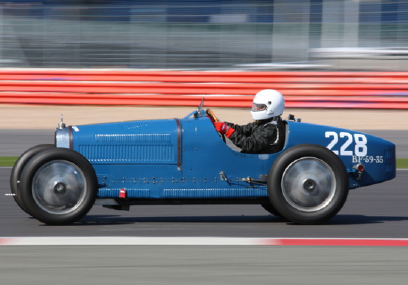
Stephen Jewell in his T35B
The national governing body said Mr. Jewell was taken to the Norfolk and Norwich University Hospital after the accident, but later died of his injuries. The Health and Safety Executive said it had begun an investigation.
The crash happened during practice for the Seaman Memorial Trophies race meeting organised by the Vintage Sports-Car Club (VSCC).
The MSA said it, along with the VSCC and MotorSport Vision - the circuit's owners - "extend their deepest sympathies to Mr Jewell's family and friends".
Paramedics were called to treat the man, who had severe injuries. He was taken to the Norfolk and Norwich University Hospital where he was pronounced dead.
Snetterton Circuit was closed for more than two hours following the collision, which delayed the racing schedule.
Thousands of spectators attended the Vintage Sports Car Festival following the success of its inaugural event last year. The 12-race schedule included a race of pre-war racing cars as well as 1950s sports racing cars and 500cc F3 cars.
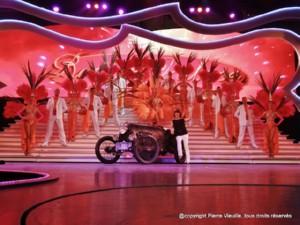 September 29, 2013
September 29, 2013 Above the two winners of the Sunday morning (without rain!) concours in the city of Molsheim. Left the winner of the Trophée Lalique, the 1935 Type 57 - van Vooren cabriolet, and right the winner of the Bugatti Foundation Tophy, Luxemburg's Goy Feltes Bugatti Type 23 with racing history.
On the right: four Brescia's were lined up at the Cemetary ceremonies..
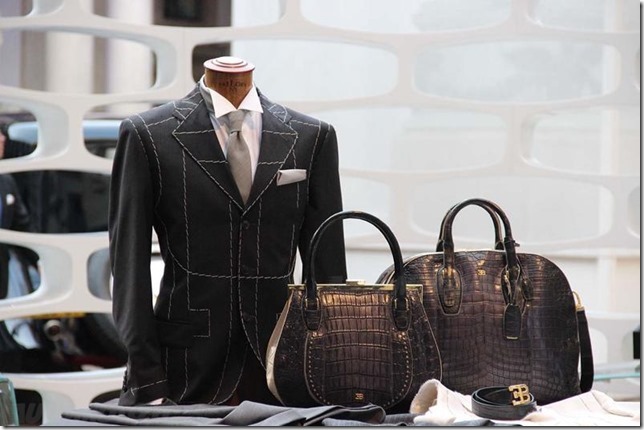
September 29, 2013
Bugatti created a buzz at Milan Fashion Week last night launching its new Lifestyle Collection under the headline of “Art, Forme, Technique”. 750 guests from fashion, arts, business and society attended the stylish event held at the renowned Brera Academy of Fine Arts. The Brera Academy was also the place where Carlo and Rembrandt Bugatti, father and brother of company founder Ettore, studied art and laid the foundations for their careers as a designer and artist.
Bugatti Hopes Handbags Will Turbocharge Brand
Luxury Car Maker Enters Fashion World to Entice New Customers
The Bugatti Veyron supercar can accelerate from zero to 60 miles an hour in just 2.5 seconds. It is with a similar rush that Bugatti Automobile SAS has entered the world of car-related fashion.
The auto maker, owned by Germany's Volkswagen AG, plans an international chain of retail stores to sell its just-launched, limited-edition Bugatti clothing and accessories to add to a small range of merchandise already on sale. Bugatti showed off its new haute couture at Milan's annual fashion fair last week.
The car maker Bugatti has launched a new tailor-made clothing and accessories service. Gilles Castonguay spoke with Bugatti’s art director, Daniele Andretta at the launch event. Report via #WorldStream.
Bugatti is joining a growing band of premium auto makers determined to enhance the appeal of their brands and entice new customers, particularly women, by selling branded clothing, handbags, watches and other accessories. It is a strategy Italy's Ferrari SpA and Germany's Porsche, another Volkswagen brand, have long adopted.
Critics say that auto makers' fashion ambition is just a form of expensive advertising with little evidence that it helps sell cars. Any extra revenue is marginal compared with car sales themselves.
Bugatti unveiled a fashion line in Milan this month, adopting a branding strategy shared by such premium auto makers as Ferrari and Porsche.
But brand experience is important when it comes to selling expensive, luxury cars that represent multibillion-dollar investments by the manufacturers. The Bugatti Veyron Sport Vitesse has a €1.7 million ($2.3 million) sticker price so buyers aren't likely to buy on impulse, say brand experts. Once the decision is made, these buyers tend to stay loyal.
"First you need to get in the potential customer's face with good strong advertising and then follow this up down the road with an impressive dealership experience," said David Haigh, chief executive of London-based Brand Finance. "It is definitely worth heavy investment to ensure the brand is in the customer's mind at the time the decision is made."
"We want to create a world around Bugatti," said Wolfgang Schreiber, president of Bugatti as well as chief executive of Volkswagen's U.K.-based luxury car maker Bentley Motors. Bugatti wants to attract customers who aspire to the car but perhaps can't afford one, without sacrificing the qualities the brand is associated with. "The products must be at the same level as the cars—high-quality, high-priced, exclusive," Mr. Schreiber said during an interview at the Bugatti fashion show last week.
Ferrari, owned by Italy's Fiat Spa is in other auto makers' headlights. Ferrari was rated as the world's most powerful brand across all product categories by Brand Finance this year based on brand affection, loyalty and the company's profitability. The Italian maker of luxury sports cars and Formula One racers plans to sell fewer cars and is reducing production this year to maintain its exclusiveness. Ferrari will limit output to 7,000 cars this year and next after selling a record 7,318 cars in 2012.
"The brand is the biggest asset and we want to preserve the value of the brand," Ferrari Chairman Luca Cordero di Montezemolo said in an interview at the Frankfurt auto show earlier this month.
Ferrari recently expanded its merchandising, licensing and services to include a tailor-made service so that customers can choose the color and leather of the interior of their cars, a restoration service for old Ferraris, and a driving school.
Auto makers are using accessories to attract women buyers, who are an increasingly important market in their own right.
Porsche created its own design label, which features a high-end accessory line, more than 40 years ago. In 2009 it introduced a women's fashion line, and earlier this year its first women's handbag. The company has signed up tennis star Maria Sharapova on a three-year deal to be its "brand ambassador" in a new global communications campaign.
Porsche says 30% of its customers are women. That compares with just 10% for Aston Martin, the U.K.-based sports-car maker best known for its link with fictional British spy James Bond.
Bentley is going down the handbag route to attract women buyers as part of efforts to double unit sales by 2018.
"Only 12% of our customers are women, which isn't good enough. We want to double this percentage within the next five years. [It is] brand extension but in a careful way," said Ariane Reinhart, Bentley's personnel director.
The first Bentley handbags went on sale last month, starting at $5,500 each.
Sabrina Tamburino Thorne was one of the first customers to purchase a Bentley bag when the British sports-car maker launched its range of accessories for women at a classic-car event in Pebble Beach last month.
"I really loved the shape and the Neptune Blue color—the size is perfect and of course it's exclusive," said the Philadelphia socialite, who is finance and budget coordinator at the Greater Philadelphia Tourism and Marketing Corp.
However, even Brand Finance's Mr. Haigh recognizes that while anything that reinforces the brand has a chance of helping car sales, the flow is usually the other way. It is the car that sells the branded goods, whether it is a Ferrari key ring or a Porsche suitcase, he said.
There is also risk that building out an automotive brand repels some customers, as well as attracting new ones.
"Bentley's [accessories] strategy is condescending and could backfire. Women are attracted to Bentleys for the same reason as men—their quality, performance, precision and heritage," said Tony Quinn, a London-based chief strategy officer at advertising agency at Publicis.
As far as I know, there already is a brand for clothes called Bugatti, and another one for shoes...
Wonder if they had any problems with that, or how much money was involved in preventing a law-suit. Editor
 September 21, 2013
September 21, 2013
Race Control Building
This year saw further commitments by many, particularly Credit Suisse, the investment bank, who have signed a 7-year commitment with Goodwood. This years outcome was that the historic Race Control building has been saved and restored to very high standards. The building served as centre of circuit activities and timekeeping from 1948-1966 – and continued its function at present day Revivals starting in 1998. However the building had suffered wear and tear to the point that pods were placed inside to support the roof structure and noone were allowed up on the platform in later years. To coincide with this years Revival opening, Race Control was officially re-launched last Friday in a ceremony led by Lord March, Sterling Moss and Ian Dembinski, head of Credit Suisse Private Banking UK.
Bugatti Gate Guards
As part of the set-up in front of the building, a pair of Bugattis acted “Gate Guards” underlining Credit Suisse´s understanding for preservation and history. This was the first showing of the Madame Itier Type 51A Bugatti restored to its original form as last raced at the Swiss Grand Prix in 1937. Goodwood´s attention to detail is phenomenal and a group of actors imitated Madame Itier, her friends, and her trusted mechanécien, Monsieur Champion. A very popular sight that drew the crowds and had cameras clicking in abundance! A small booklet was handed out explaining the history and research of both cars.
- The new Bugatti will be a supersportscar again, not a four-door.
- It will be an entirely new design, with new chassis.
- The car will also have a new engine, no specifications disclosed yet.

December 13, 2013 EAA WRIGHT BROTHERS MEMORIAL BANQUET - Bugatti 100P Presentation Oshkosh, USA
The effort to recreate one of aviation history’s most beautiful but unproven designs will be the highlight presentation at EAA’s annual Wright Brothers Memorial Banquet. This year’s banquet will commemorate the 110th anniversary of the Wright Brothers’ first powered flight at Kitty Hawk, N.C.
Join us as EAA member Scotty Wilson describes his quest to build a full-scale, flyable reproduction of the Bugatti 100P racer, “the most historically significant airplane that never flew.”
Tickets for the banquet are $50 for EAA members and guest, $60 for non-members/guest, and include the reception, full-service dinner, and evening program.
More info at airventuremuseum.org
the Friends of Prescott have an auction underway to help raise funds for ongoing maintenance and support for the hillclimb. There are a number of unique bugatti experiences, books and automobilia that might be just what some of you 'hard to buy for' enthusiasts might appreciate!
The website is via bugatti.co.uk
In the menu on the left of that page you will find 3 pages with the offers, and a 3rd with the ïnstructions how to make a bid.
 Bugatti Type 57 Aerolithe
By Francois Vanaret |

September 10, 2013
Following the successful launch of its “Les Légendes de Bugatti” (Bugatti Legends) series a few weeks ago in Pebble Beach in California, Bugatti presents the second vehicle in this exclusive edition as a world premiere at the 65th International Motor Show in Frankfurt. The French luxury car manufacturer intends the Bugatti Grand Sport Vitesse “Jean Bugatti” to be a celebration of the oldest son of company founder Ettore Bugatti and his most famous creation, the Type 57SC Atlantic. Like all other five models in the Legend series, the “Jean Bugatti” is limited to three vehicles. It costs 2.28 million euros (plus tax and other charges).
With its “Jean Bugatti” Legend model, Bugatti pays homage to a prominent figure in 20th century automotive history. Gianoberto Carlo Rembrandt Ettore Bugatti, known as Jean, was the eldest son of Ettore Bugatti and the most gifted of his four children. From the late 1920s onwards, Jean used his own structural and design ideas to exert more and more influence over the development of the company located in Molsheim, Alsace. In 1936, he took over as head of the company at the age of 27. By the time of his tragic accidental death in 1939, Jean had secured his place in automotive history thanks to his pioneering engine and chassis designs and concepts for vehicle bodies.
“Jean Bugatti is a Bugatti legend,” says Dr Wolfgang Schreiber, President of Bugatti Automobiles S.A.S. “Along with his father Ettore, Jean played a critical role in shaping our brand. Jean managed to combine the artistic roots of Bugatti with his father’s innovative automotive technology, and from that developed a design which is still reflected in the brand today, finding expression in our brand values of ‘Art, Forme, Technique’.”
One of the most extraordinary designs created by Jean Bugatti has to be the Type 57SC Atlantic, one of the most exclusive and exceptional sport coupés ever built and ranking among the most expensive vintage cars in the world. The Legend vehicle to be unveiled in Frankfurt is a call back to La Voiture Noire (‘The Black Car’), an Atlantic model which was driven by Jean Bugatti himself and has been lost since the Second World War.
“The Bugatti 57SC Atlantic is an icon. For many, it is one of the most elegant and valuable sports cars in automotive history,” asserts Wolfgang Schreiber.
“Jean Bugatti was a gifted car designer who knew to mirror the 1930s style of avant-garde in the design of the Bugatti car bodies,” explains Achim Anscheidt, Chief Designer at Bugatti. “His jet black La Voiture Noire was more than just Jean’s ‘private’ car. It was also his most impressive work of art – breathtakingly sporty dimensions paired with fluid, elegant lines and the unmistakeably expressive Bugatti DNA.”
The technology in the Bugatti Legend Edition “Jean Bugatti” is based on the Bugatti Veyron 16.4 Grand Sport Vitesse, whose 8-litre W16 engine generates an enormous 1,200 PS and an unparalleled 1,500 Nm torque at 3,000 to 5,000 rpm, and which can go from 0 to 100 km/h in 2.6 seconds.
Design: For the first time ever, the Bugatti horseshoe sparkles in precious platinum
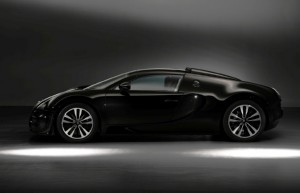
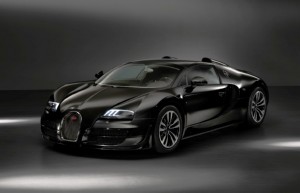
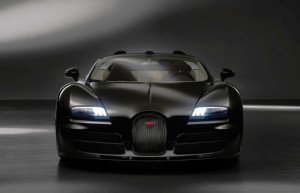
In developing the Jean Bugatti Legend Edition, the designers at Bugatti aimed to follow the concept of its historic predecessor, the Type 57SC Atlantic La Voiture Noire, as closely as possible.
Exterior: The body of the Jean Bugatti Vitesse Legend Edition is constructed entirely from jet black, clear-coated carbon fibre, making it the embodiment of elegance and the apex of technical engineering. The use of platinum lends an air of extravagance to the vehicle, with the famous Bugatti horseshoe on the front grille and the EB logo on the rear taking on a resplendent appearance. Bugatti is using this precious material for the very first time on the exterior of one of its modern models.
The vehicle’s elegant, minimalist appearance is further punctuated by its wheels, which feature black diamond-cut rims.
In reference to the Legend Edition’s namesake, the signature of Jean Bugatti has been lasered onto the petrol and oil cap and painted Arctic grey.
Interior: The designers also took care to adhere to the motif of the historic La Voiture Noire as much as possible for the interior of the Vitesse Jean Bugatti Legend Edition. As such, it has been fully fitted out in leather. The Vitesse will also feature the same beige and brown tones that were present in the Type 57SC Atlantic. The seats, instrument panel, steering wheel, dash panel, centre console, door trim panels and windscreen crossmember are all rendered in chocolate brown.
As in the original vehicle, the chocolate brown is contrasted against the leather upholstery in a light beige silk colour across the extended centre console. This upholstery is continued in the footwell, the outer door trim panels and the handle recesses. The colour of the decorative stitching in the vehicle has been selected to complement the leather used.
The intricate, particularly eye-catching embroidery on the doors and the cover of the rear storage compartment once again harks back to the vehicle’s legendary predecessor, given that the side silhouette of the Type 57SC was embroidered onto the chocolate brown doors using contrasting beige silk thread. From a bird’s eye view, the Atlantic’s silhouette is immortalised using brown thread for decorative stitching on the rear beige-coloured storage compartment.
The results of this passion for detail and the desire to use the finest materials throughout the engineering process can be observed in the interior’s steering wheel as well – as for the exterior of the vehicle, the EB logo has been styled in gleaming platinum. Also staying true to the original Type 57SC is the selector lever, which is rendered in valuable rosewood.
Additional specific Legend Edition features in the vehicle include a leather insert embossed with the lettering “Les Légendes de Bugatti” in the extended section of the centre console, and door sill plate displaying the likeness and signature of Jean Bugatti.
A historic predecessor: the “Voiture Noire”

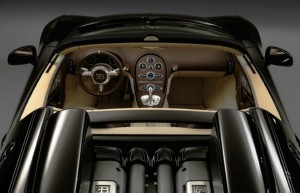
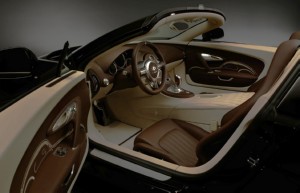
Just four Type 57SC Atlantic vehicles in total were built between 1936 and 1938. Only two of these vehicles still exist today in their original condition. The Atlantic is the most famous version of the Type 57. At the time, Jean Bugatti wanted to offer a motorsport version of the standard model, thereby resulting in production of the SC version (SC stands for supercharged).
Jean Bugatti, whose skill in developing unique body designs was already proven by the Type 41 Royale, Type 55 Roadster and Type 50, was responsible for the shape and style of the Atlantic, which was intended to be extremely light and aerodynamic. Aluminium was the material chosen, giving the Atlantic its unmistakable design feature – a clearly accentuated dorsal seam which runs at a right angle from the windscreen to the rear bumper and effectively welds the two halves of the aluminium body together. This element continues to play a fundamental role in vehicles designed by Bugatti even today. As the floor of the vehicle sits between the longitudinal chassis members rather than on the frame itself, this means that the wheels are offset from the body and accentuated by enormous wings, thereby providing the car with a footwell. Seen from above, the extremely long bonnet flows to the rear of the vehicle in an oval shape, further highlighting the graceful and elegant design of the Atlantic.
The sport coupé was equipped with a straight-eight engine with 3,257 cm³ displacement, which produced 200 PS. However, even though it was able to reach speeds of over 200 km/h at the time, it was never entered into a race.
The specific Atlantic which served as the godfather of the Jean Bugatti Legend Edition is the legendary La Voiture Noire, which was the first of four vehicles produced in total. It belonged to Bugatti and was lost in transit amid the confusion of World War Two. The location and circumstances surrounding its disappearance are still shrouded in mystery.
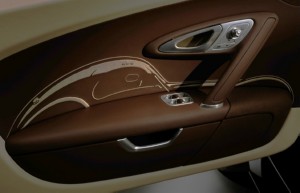
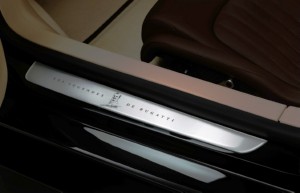
All in all, the Veyron is being "upgraded" for the n-th time, with different colours, a few drawings on the outside and the interior, and a fancy name referring to a marque established a century earlier by a different company.
It is about time that a new car is engineered, be it a new über-supercar or a true Royale replacement, and that these tricks to draw attention to always the same car (which is quite a brilliant achievement of course) are abandoned. - Editor
Pur Sang BC122 (EX 9434) sold for £117,980, far better than the estimate:£60,000 - 80,000
The third CEO of Bugatti in three years, Wolfgang Schreiber, the engineer that made the Veyron project work in the first place. Since then, Bugatti has built slightly over 300 hard-tops, including 1200-hp Supersports, and has built 90 of the expected 150 open-roof Grand Sports and 1200-hp Vitesses, the last 60 of which will be built over the next two and a half years. As such, Schreiber recently announced that the long-rumored Super Veyron is off the table. However, a replacement for the world’s fastest, most powerful, and expensive hypercar is in the works. Which makes sense with Schreiber at the helm. But that leaves the Galibier nowhere.
Schreiber feels there isn’t enough bandwidth in the Bugatti brand to support both a super sports car and a super sedan. When I pointed out that back in the brand’s heyday, Bugatti simultaneously sold both a sports car and the Royale, Schreiber was quick to point out that the massive Royale was a sales failure, with only six ever completed and sold. But it sounds as if there’s simply no business case for a sedan bigger and more luxurious than the Rolls-Royce Phantom. Pity, as the Galibier looked both promising and decadent. Of course, who knows how the next head of Bugatti will feel about the subject?
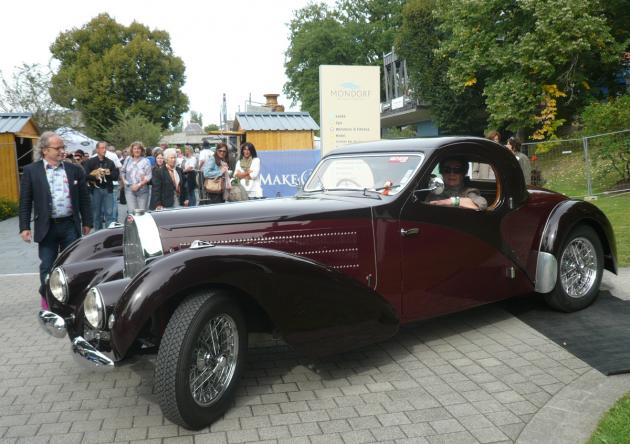
Chassis 57598 was driven to and from the event from its Alsace home by proud owner Mrs Börg, and was the clear standout among a field of 150 glorious classics from Germany, Belgium, France, The Netherlands and the host nation. A judging team including Andrea Zagato and Jean-Marie Schmit, president of the Lëtzerbuerger Oldtimer Federatioun, picked winners for several special anniversary classes celebrating 110 years of Harley Davidson, 100 of Aston Martin (including a fabulous DB4 with rare factory hard-top, above) and 50 years of the Porsche 911, along with the main awards for different age groups.
Source: www.classicandsportscar.com
Lot 138: 1924 Bugatti Type 35 Grand Prix, Chassis no. 4323 The Prototype and Bugatti Works, ex-Sir Robert Bird, Col. G. Niles and Henry Haga, Estimate: US$ 1.5 million - 2.5 million / £980,000 - 1.6 million / €1.1 million - 1.9 million, Not Sold
Lot 185: 1928 Bugatti Type 44 Cabriolet Chassis no. 44769, Engine no. 502 Ex-Jean De Dobbeleer, Estimate: US$ 385,000 - 450,000 / £250,000 - 290,000 / €290,000 - 340,000, Sold for $363,000 / €272,113 / £232,181
Gooding & Company, Pebble Beach Auctions, August 17-18, 2013 :
Lot 017: 1925 Bugatti Type 35 Grand Prix Chassis no. 4613, Engine no. 44, Estimate: $2,500,000 - $3,000,000, Not Sold (highest bid $2.100.000)
Lot 021: 2010 Bugatti Veyron Grand Sport Chassis no. VF9SK2C28AM795302, Estimate: $1,100,000 - $1,400,000, Sold for $1,155,000
Lot 123: 1937 Bugatti Type 57SC Atalante Chassis no. 57523, Engine no. 235, Estimate: $8,000,000 - $11,000,000, Sold for $8,745,000
Thanks to: Christophe Chanterault
Lot 311: 1928 Bugatti Type 37 Châssis 37363, Moteur 252, Estimate: 450.000 €-600.000 €, Sold for 550.000 €

Bugatti, a brand with a rich history unique in the car industry, is celebrating its heroes. The French luxury marque will bring out an exclusive edition, “Les Légendes de Bugatti” (Bugatti Legends), to commemorate the renowned names which have played a crucial role in its history and which have helped creating its mystique. In the 90th anniversary year of the 24 Heures du Mans, the first Legend is dedicated to a personality who is central to the history of motor sports and intimately linked with the Bugatti company: Jean-Pierre Wimille, who garnered two victories for Bugatti at Le Mans. The Bugatti Legend “Jean-Pierre Wimille” will make its début in the eyes of the world at the US The Quail/Pebble Beach weekend taking place from 16 to 18 August. The next twelve months will see the launch of six individual Bugatti Legends based on the Bugatti Grand Sport Vitesse.
Dr. Wolfgang Schreiber, President of Bugatti Automobiles S.A.S.: “This brand has been in large part defined by outstanding personalities and historically resonant moments. We want to tell the story of the brand through these Bugatti legends, and at the same time create a link between its past and presence.”
The Bugatti Legend “Jean-Pierre Wimille” relates to the successes of the eponymous racing driver who won Bugatti two victories at the 24 Heures du Mans: in 1937, driving a Bugatti 57G Tank co-piloted by Robert Benoist, and repeating the feat in 1939, this time supported by Pierre Veyron in a 57C Tank.
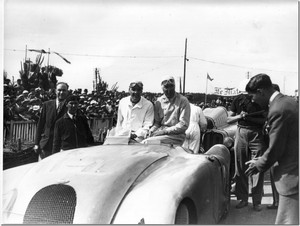
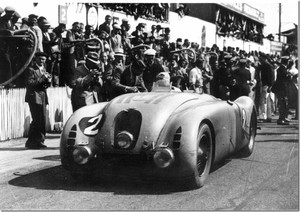
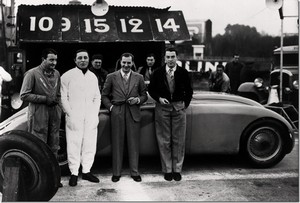
Left: 1937 – Jean-Pierre Wimille and Robert Benoist after winning Le Mans for Bugatti for the first
time, middle: The winner of Le Mans 1937: Jean-Pierre Wimille in the Type 57G Tank
, right: The factory drivers “Williams“, Veyron (from left) and Wimille (far right) with Jean Bugatti
(between them) in front of the Type 57G Tank
The winning race car from 1937 is the inspiration behind the design of the “Jean-Pierre Wimille” Bugatti Legend. For the historic race the 57G Tank appeared in the racing blue finish that habitually identified French racing cars. Accordingly, this Vitesse now shines in blue clear-coated carbon fibre and a light Wimille Bleu paintwork finish.
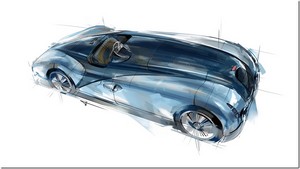
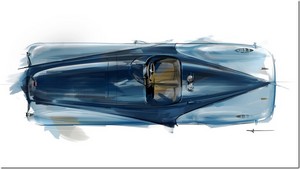

Left and middle: sketches of the Type 57 G Tank, the winning race car from 1937, which was the
inspiration behind the design of the “Jean-Pierre Wimille” Bugatti Legend car
, right: Design sketch of the Bugatti Legend „Jean-Pierre Wimille“.
The colour scheme is continued in the supercar’s interior, as Achim Anscheidt, chief designer at Bugatti, explains: “The materials and colours selected, as well as a host of details, all reference the essential characteristics of the classic models driven by those figures to whom our edition pays homage. In each case, this care has resulted in vehicles in which the authenticity of the past is combined with the modern design, the sportive superlative and the luxurious comfort of Bugatti as an icon of the present. With these Bugatti Legends we are giving history a modern makeover.”
The six Bugatti Legends are all based on the Bugatti Veyron 16.4 Grand Sport Vitesse. This super sports car, launched in Spring 2012, is officially the fastest series roadster in the world since achieving 408,84 km/h with the top down in April 2013. Centred round an eight-litre W16 engine delivering 1,200 PS, the Vitesse produces unequalled maximum torque of 1,500 Nm (at 3,000 – 5,000 rpm), and accelerates from 0 to 100 km/h in a lightening 2.6 seconds.
The production run for the Bugatti Legend “Jean-Pierre Wimille” will be limited to three vehicles.
About Jean-Pierre Wimille
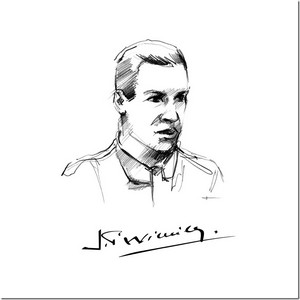

Left: Portrait of Jean-Pierre Wimille. sketched by a current Bugatti designer, right: Jean-Pierre Wimille (1908 – 1949), two-time Le Mans winner for Bugatti.
Jean-Pierre Wimille was one of the longest-serving test drivers at Bugatti. The son of a journalist, he was born in Paris on 26 February 1908 and drove almost exclusively for Bugatti throughout his racing career. With a number of victories already under his belt, in 1933 Ettore Bugatti invited him to take up the position of official test driver for the brand. He joined Bugatti at a point when its last great racing triumphs lay a few years in the past, making the string of victories he brought home to Molsheim over the following years even more significant. In his very first year he came first in the Algerian Grand Prix, then in 1935 he collected the title in the then-famous hill climb at La Turbie near Nice driving a T 59, following this with a second place in the Tunisian Grand Prix and fourth place in Spain.
And it was Jean-Pierre Wimille who brought Bugatti what was to be its last ever racing number one, in 1947 at the Bois de Boulogne, behind the wheel of a 4.7 litre Monoposto Type 59/50 B. Wimille was a world-class driver, who played a key role at Bugatti, especially as the brand’s racing era came to an end. His greatest racing achievement was without doubt his twin victories for Bugatti at Le Mans. He died in a car crash in 1949 in Buenos Aires.
About Bugatti
Unlike other automotive brands, Bugatti originated in the field of art. The company founder Ettore Bugatti succeeded in uniting this artistic approach with his technical innovations, thus creating the foundation of a design language that was to mould the Bugatti marque. The result has been a series of vehicles far ahead of their time, and which are today numbered amongst the most valuable classic cars in the world. The brand’s central philosophy of “Art, Forme, Technique” is a description of its mystique.
Its history is marked by a host of dazzling automotive masterpieces but also by an unmatched racing record. Although the grand Bugattis such as the 57SC Atlantic or the majestic Royale, are still regarded as superlative, the lightweight, agile and temperamental Type 35, which won Bugatti so many titles, is just as representative of the Bugatti brand. The particular fascination of Bugatti’s racing past springs however not only from the race cars themselves but equally from the great race drivers of yesteryear.
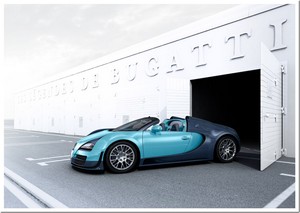

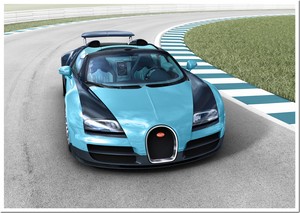
Bugatti 16.4 Veyron Grand Sport Vitesse “Jean-Pierre Wimille”, note the imitation Molsheim factory doors in the firstcomputer image.
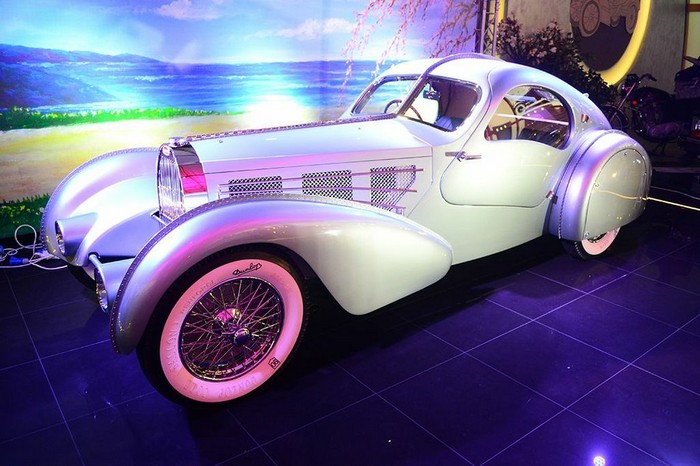
Historical Car Museum hosts the Bugatti Type 57 Aerolithe.
 Kuwait May 12, 2013:
Kuwait May 12, 2013:The Historical, Vintage & Classic Cars Museum in Kuwait revealed one of the rarest historic classic car, a remake of the 1935 "Bugatti Type 57 Aerolithe" in a special exhibition that is available to public viewing from 13th of May to 15th of June 2013, giving them an interesting opportunity to visit this special car for the first time in the Middle East.
Under the patronage of His Highness Sheikh Nasser Mohammad Al-Ahmad Al-Jaber Al-Sabah, and His Excellency Sheikh Mubarak Al-Sabah Al-Salem Al Hamoud Al Sabah, a member of the Board of Trustees at the Museum, and Mr. Host Brunung - President of the International Federation of Historical Automobile (FIVA), and His Excellency Fabrizio Nicoletti Italian Ambassedore to Kuwait, and His Excellency the Russian Consul in Kuwait Mr. Sergei Alexeev. Also attended from United Stats of America, the owner of the car Mr. Christopher Ohrstrom, and Mr. David Grainger – GM of the Guild Automotive Restoration Company in Canada. And from the United Kingdom, Mr. Douglas Hogg – the young Designer of the future concept of the 2025 Aerolithe, and his father Mr. Phil Hogg. Also attended a number of Kuwait Car Dealers and Car Collectors and Museum members and Kuwait VIP’s.
 The arrival to Kuwait of the legendary classic car which is the oldest in the history of luxury car making is part of the museum's objectives of satisfying the desires of car lovers. The exhibition presents sports car enthusiasts an historic opportunity to get to know one of the fastest and oldest cars that was made back in the 1930s.
The arrival to Kuwait of the legendary classic car which is the oldest in the history of luxury car making is part of the museum's objectives of satisfying the desires of car lovers. The exhibition presents sports car enthusiasts an historic opportunity to get to know one of the fastest and oldest cars that was made back in the 1930s.
In addition, there will be also a display of the futuristic interpolation of the Aerolithe, from a concept design, done by Douglas Hogg in 2010 to resemble the Bugatti Aerolithe 2025 as a graduation project while he was studding at Coventry University in the United Kingdom. Also at display is a repainting of an original painting of the “Cream du la Ment” the Aerolithe original colour name (As many Bugattistes know, the "Creme du menthe" has no relationship to this car, it was the code name for the T57 prototype with independent front springs, Ed.), done by one of the Bugatti technician and given as a gift to Mr. Jean Bugatti, to show their appreciation to such a great car. This painting became the only evidence that gave us the true colour of the original car.
The car which was re-manufactured by a Canadian company, in the same original design and technical information and the craftsmanship of the Bugatti technicians while they build the original Aerolithe. They used all original Bugatti parts in the process with matching number, of chassis, engine, transmission, rear differential and some of the front axle. For nearly 10 years, the car's re-creation has captured the attention of classic and historic car enthusiasts who remained watching with keen interest for the time of its launch, until it was announced it was debuting in Kuwait before anywhere else in the world.
The choice of Historical, Vintage & Classic cars Museum from all the museums in the world by the manufacturers for the debut launch of the car, attests to the importance and global position of the museum and an affirmation of the cooperation in partnership with the International Federation of Classic Cars – FIVA, which was confirmed after the museum's several successes in the launch of specialized cars, most important of all was the "Kuwait Concours d’Elegance", which is considered one of the most famous competitions in the auto world.
Masterpiece
On this occasion, Mr. Mustafa Makhseed Manager of the Committees at the Historical, Vintage & Classic Cars Museum said "We are proud of what has been achieved by the Museum in hosting this huge event in the automotive world, and are very pleased especially with the confidence reposed in Kuwait to be the first country on the globe to showcase the reincarnated the “1935 Bugatti Type 57 Aerolithe".
He stressed further that the exhibition is one of the many ways in which the museum satisfies the teaming numbers of historic and classic car enthusiasts in the country, adding that hosting of such high profile events will continue in the future. Makhseed noted that hosting the event is a great achievement for the museum since it was chosen from among many high profile museums in the world to host the event and adds to the long chain of achievements chalked since the museum's inception.
Mr. Makhseed expressed his sincere thanks to His Highness Sheikh Nasser Mohammad Al-Ahmad Al-Jaber Al-Sabah, for his continued support and sponsorship of the museum, which represents a monumental historic asset that places Kuwait among the ranks of countries with international car museums. He also thanked all those involved in organizing the event, especially Mr. Abdulaziz Ishaq member of the Board of Trustees for his great efforts and continues support and help to overcome all the challenges, and the distinct role played by the members of the Board of Trustees in the museum.
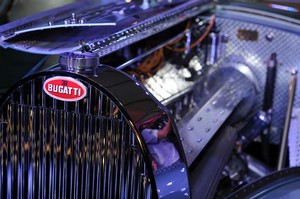 High International Appreciation
High International Appreciation
For his part, Eng Zakaria Dashti, Director of the Media Committee at the car Museum, said "The museum has been chosen from among the many international museums specializing in Classic and historic cars to be the first to witness the reveal of the 1935 Bugatti Type 57 Aerolithe. He added that the selection of Kuwait as the first point from which the car is showcased to the world is a great achievement and a huge expression of confidence that attests to the prestige enjoyed by Kuwait as a center for classic cars in the Middle East. He also noted that the month-long automobile show event is not just a regional but a world level event.
He pointed out that this position achieved by the historic and classic cars Museum in Kuwait came as a product of years of continuous hard work in addition to the museum's success in hosting major unique events in the world, including the "Kuwait Concurs d'Elegance" which had excellent feedback in terms of organization and preparation.
Dashti expressed his pride in the museum's achievements, saying that those successes collectively have put it firmly on the world map of classic cars, which rightly confers on it the Classic Car Center of the Middle East. Additionally, the museum was also able to communicate with an audience of car enthusiasts in Kuwait and the region, until it became well known as a go-to place for updates in the auto world.
He stressed that the museum present this event for car lovers in Kuwait and the Gulf states, as well as the world, as an opportunity to visit and see this legendary car that is showcased for the first time during the period from 13 May to 15 June 2013 to learn about its long history as well as see the version of the model for the design of the modern concept version of Bugatti Type 57 Aerolithe car, which was carried out by the young car designer Douglas Hogg.
Bugatti 1935
The Aerolithe (or Electron coupe as it was also known) was a one off prototype designed by Ettore's son Jean for the 1935 Paris motor show. It was a quantum leap forward in styling, aerodynamics and engineering from anything that had come before and was the undoubted star of the show.
It featured superlight magnesium bodywork - a first at the time. The famous riveted construction that was used in aerospace was because of the great difficulty in using magnesium - it is difficult to weld as it can catch fire easily and it is extremely difficult to work to shape. The Aerolithe went on to star at the London Motor Show later in 1936, but then mysteriously disappeared off the face of the earth. To this day, no one knows for sure what happened to it.
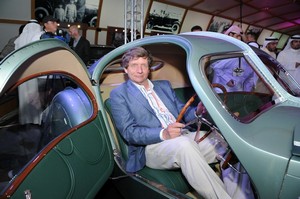 In 1936 Bugatti presented the legendary Bugatti Type 57SC Atlantic, the production version of the Aerolithe, but it was not build from Magnesium due to all the difficulties and problems involved, it was made form aluminum, but kept the famous riveted construction to resemble what was so unique about the Aerolithe. Only four Atlantices have ever been made into production, only three remain known today. One have been sold at auction at 40 Million US dollars, making it the World Most Expensive Car. (The sale was not at auction, but privately at a reputed 32 M$, Ed.)
In 1936 Bugatti presented the legendary Bugatti Type 57SC Atlantic, the production version of the Aerolithe, but it was not build from Magnesium due to all the difficulties and problems involved, it was made form aluminum, but kept the famous riveted construction to resemble what was so unique about the Aerolithe. Only four Atlantices have ever been made into production, only three remain known today. One have been sold at auction at 40 Million US dollars, making it the World Most Expensive Car. (The sale was not at auction, but privately at a reputed 32 M$, Ed.)
After 78 years, a company in Canada called 'the Guild of Automotive Restorers' has been working on building the Aerolithe. They have worked on many other projects but this one was the most important. They kept it original and faithful to what is known of the original - which is not a lot! Around eleven black and white photographs of the original car from Paris and London Motorshows and some stories from Bugatti enthusiasts is all what there is to be known to have existed. After huge research and collecting of information, they managed to build the car in the same exact specifications and craftsmanship that the Bugatti technician used in building the Aerolithe, the most important and challenging decision was using Magnesium to build it just like the original Aerolithe in 1935.
To construct it, the restoration team had to learn to handle dangerous magnesium. The team had spent a long time determining which period-correct alloy to use; in the end, the appropriate metal turned out to be much more difficult to shape than more modern mixes. Color was a key question for the team as all existing photos were black-and-white. However, a painting of the car existed, and by comparing this with other Bugatti colors, the original paint shade was identified.
Even finding tires required extra effort. The photographs of the car at its only Motor Show appearance displayed it shod on Dunlop Balloon whitewall tires. Nothing suitable could be found, so the tires were custom fabricated after long but successful negotiations with the owners of the Dunlop trademarks. From start to finish, the research, planning and execution of the Aerolithe build took five years of trial and error.
In early 2010, a young car designer, Douglas Hogg, started work on the futuristic design of the Bugatti as his Graduation Project at the University Of Coventry, England. He worked on a concept model of imaginative design of the car with the help of his father Philip Hogg.
Inspired by the style of founder of Bugatti Mr. Ettore Bugatti, as he used in various possible ways in order to reach perfection. Hogg suggested that the concept would be a 2025 year car and it would be the fastest and lightest car around the world.
For those wishing to enjoy viewing the car and the rest of the exhibits in the museum, please visit the museum during the official working hours in the showroom from 8am to 8pm at the museum's headquarters in Shuwaikh Industrial Area 1, Block 1, Street 7, Building 48. Tel: 24819186 - Fax: 24824037. - Free admission
Received from Zakaria Dashti
The article was published unaltered, with a few remarks by the editor.

S U M M A R Y
In this case the dispute between parties was the legality of an entry in the "Bugatti Register The Netherlands-Belgium Vol. III ", in the description of a Bugatti indicated as type '45 'R that it is built on a copied (replica) chassis. According to the former owner, the subject indication is illegal because the car has an original chassis and the mentioning in the Register has an adverse effect on its value. Ernst seeks a ban on further issuance and various rectifications. The claim was rejected in summary proceedings and is now confirmed by the appellate court.
According to the judge the sources mentioned by [Jansen] considered in mutual conjunction provide sufficient support for the statement that the Bugatti has a (replica) chassis manufactured around 1978 by, or on behalf of, [Jonesl], while the documents submitted by [Ernst] in opposition thereto in the proceedings lack sufficient weight to require [Jansen] to further qualify his referred to communication. The Court upholds the judgment, which was appealed.
The other documents, put forward by [Ernst] in the opinion of the appellate court provide sufficient grounds for considering that the entry in the Register is sufficiently supported by the facts, and does not need to be retrospectively rectified. To this end, the Court considers as follows.
[Ernst] relies primarily on the report by Matti from May 15, 2011. [Jansen] questioned whether that report relates to the present Bugatti, because Matti writes about a car with chassis number 54'206. However, even in the Register, this number is associated with the Bugatti in dispute (under the bottom picture), so the court assumes that the report on that car is relevant. In the report Matti writes inter alia, that the car with engine number 4, at least until 1965, was absolutely original. He writes that in February 1978 he has seen that [Jonesl] has made several changes to the car but that "as a whole, the car was kept original (engine, chassis)." Apart from the statement by [Jansen], and not disputed by [Ernst], that the car was sold 10 months later to [Howell], so that it can not be excluded that the chassis after the visit of Matti was replaced by [Jonesl], the Court in this regard considers the report not sufficiently convincing. Indeed Matti does not mention on which he bases his observation. Since the parties agree that, if the chassis is counterfeited, this is done to the exact specifications, it is without the lacking further explanation, not clear how Matti has determined that it was original.
[Ernst] referred in addition to the metallurgical investigation by GL Werkstoffe und Schadenanalyse (hereinafter "GL"). The determination of GL that the steel of which the chassis of the car is made has not been produced in Western Europe since several decades ("in Westeuropäischer Produktion schon seit mehrere Jahrzehnten nicht mehr hergestellt"), does not rule out that the steel was still used late seventies in America, at least could have been available, as [Jansen] stated. In addition, GL qualifies this finding only as a possible indication of the originality of the chassis.
During the pleadings, [Ernst] requested the court to appoint an independent expert in order to once and for all obtain a declaration about the chassis of the Bugatti being original or not. Also in view of the resistance against this request by [Jansen], the court sees no reason to do so. Besides it concerns an interim order. Moreover, it is not to be decided whether the chassis is original. The question to answer (for the moment) is whether [Jansen] acted with sufficient care by the entry in the Register that the chassis of the Bugatti is counterfeited, or whether the evidence currently available gives rise to requesting rectification of the disputed entry or to nuance it. The first question the court answers affirmatively, the second negative. By that state of affairs the interest of [Ernst] in the requested relief cannot be awarded.
The interest of [Ernst] should also be put into perspective.
In the first place, as has been established, there is not an imminent loss, but merely a possible reduction in appreciation. [Ernst] knew, based on the sales information provided by [Howell], that he bought a Bugatti of which it was believed that this had a replica chassis.
In the second place, there are, based on all the above considerations, many other sources, in which it is stated that the Bugatti rests on a replica-chassis. The suggestion of [Ernst] in the pleadings that the Register it is more affirmative than other sources referred to, cannot be followed by the court, given content thereof.
Photo: at the top (B&W) the Type 45 engine as fitted first in a T35 chassis, and below that (colour) in the replica T45 chassis, note the longer wheelbase and the rear springs outside the body, the longer wheelbase and other details.
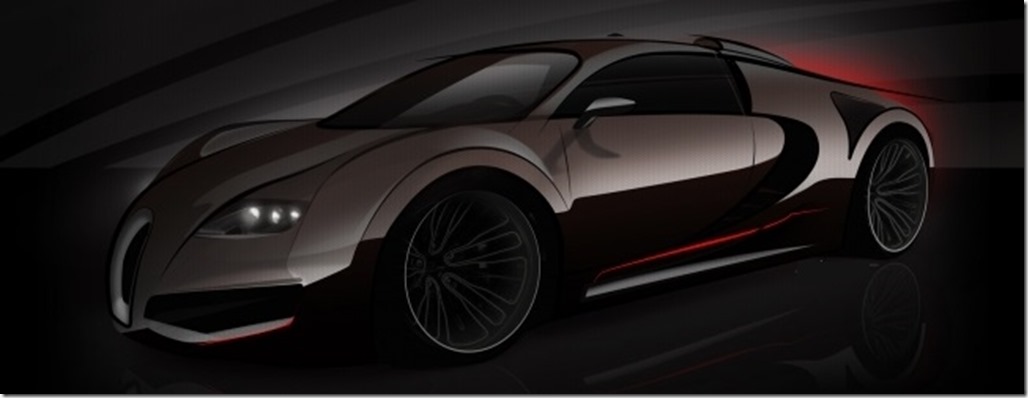
Compared to the Veyron Super Sport, the new variant will make extensive use of carbon fiber which will lower weight by approximately 200 kg (440 lbs) so it should tip the scales at around 1,688 kg (3,721 lbs). In addition, output of the quad-turbo W16 engine will be lifted from 1,184 bhp (883 kW) to more than 1,500 bhp (1,118 kW) by increasing the mill’s capacity rather than adding electric power as it was believed in late 2012.
Rumor says top speed will be limited by tire technology but the report mentions at least 280 mph (450.6 km/h) to entice buyers willing to spend an alleged 5M GBP (5.8M EUR or 7.7M USD) price tag.
Reports that a final, ultra-extreme version of the Bugatti Veyron will be launched early next year have gathered pace, with an insider admitting to Autocar that the company is eager to produce a version of the car that is “a fantasy in terms of its performance”.
Our source said: “We are looking at several options. The reality is that we are not under time pressure because we are confident of selling out the full Veyron production run regardless.
“Only after that can we see if there is time and appetite for such a programme. It would be expensive and time-consuming, so we must be sure it is worth it.”
Likely modifications over the Veyron Super Sport on which it would be based include dramatic weight-saving technologies, focusing on more extensive use of carbonfibre to cut about 200kg from the Super Sport’s 1888kg kerb weight, and a dramatic increase in power from the Super Sport’s standard 1184bhp.
It has been claimed that the potential power output from the quad-turbo W16 engine is more than 1500bhp, which would be achieved by increasing its capacity. The possibility of combining it with an electric boost system has been played down, though.
The top speed is likely to be dictated by the limits of tyre technology, but with the Super Sport coupé having already achieved a street-legal record of 267.82mph, it is likely that the most extreme version of the car would need to be capable of achieving at least 280mph to satisfy the demands of potential customers willing to pay the mooted £5 million price.
From: Autocar
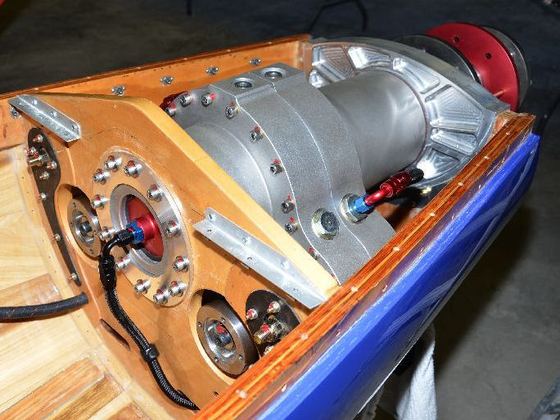
We reached a milestone today with the final installation of the gearbox, a 30-month collaborative project between the US and the UK. We've said this before, but it bears repeating; it might be easy for Boeing to build components in different parts of the world and assemble them together to make an airplane, but has been a challenge for us. Fortunately, everything fit perfectly!
More news on the Replica Bugatti airplane on BugattiAircraft.com
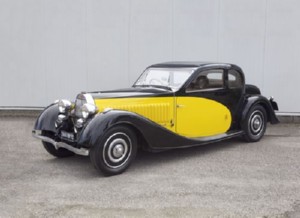 October 12 - 13, 2014 The Karl Ritter Collection Auction, by Coys Graz, Austria
October 12 - 13, 2014 The Karl Ritter Collection Auction, by Coys Graz, Austria
The Type 57 was undoubtedly the best-selling of all Bugatti models, and its success was assured right from the beginning, from its introduction at the 1934 Paris Salon de l'Automobile. At the heart of the car was the jewel-like straight-eight engine of 3.3 litres, a direct descendant of the world-beating Type 51 Grand Prix racing car's powerplant, and right from its inception the Type 57 was to be clothed with some of the most beautiful coachwork of its era..
Among these was the superb Ventoux coupe, a Bugatti factory design, and it was this bodywork which was chosen when Chassis 57286, an early model from February 1935, was sold later that year to a customer in Normandy. The car spent the next fifteen years in the hands of a small number of plainly careful owners in Northern France and Belgium, before finally coming to rest in an extraordinary collection owned by one Michel Dovaz on a farm not far from Paris.
Over the next three decades rumours began to spread round the world of vintage and classic motoring of a hidden collection of fifty-five cars in various stages of originality and dilapidation, These grew until the situation finally peaked with the publication in 1986 of a book by photographer Herbert Maselmann and writer Halwart Schrabr entitled 'The Sleeping Beauties', with a superbly atmospheric photograph of Chassis 57286, thick with dust but completely original, on the front cover.
Clearly Monsieur Dovaz's cover was now completely blown, and gradually he began to find himself besieged by journalists, fortune hunters, thieves and, inevitably, the French tax authorities. Finally a big part of the collection was sold to pharmaceutical magnate Jean-Michel Bonabosch, and when some of the cars came to auction in 1993, one of the most picturesque episodes in the life of 57286 came about.
The car, bearing decades of undisturbed dust, came into the hands of celebrated Bugatti expert and restorer Andre Lecoq, who demonstrated his mastery of his craft by restoring exactly half of the car along its central axis from front to rear. The result was the sensation of the 1994 Paris Retromobile classic motor show, and, when finally the car completed its restoration to typically supreme Lecoq standards, it passed through the hands of some opulent French collections before finally arriving at the Automobile Museum Stainz in 2000.
Of course Chassis 57286, after such an astonishing level of restoration following such sparing use, remains in truly remarkable condition; very few Bugattis can have so romantic a story. It will be handed to its next owner with a French Carte Grise registration document bearing the stamp of Andre Lecoq.
 1938 Bugatti 57 C Stelvio by Gangloff, chassis 57716
1938 Bugatti 57 C Stelvio by Gangloff, chassis 57716
This Bugatti 57 C was sent by the Bugatti works on 26.july 1938 to coachbuilder Gangloff S.A. at Colmar who delivered the completed car on 12th September with its magnificent Drophead Coupe body “ Stelvio” named after a mountain in the alps. It was registered in October of the same year and sold to a Mr. Jouille of Marseille via Bugatti`s Marseille agent Gaston Descollas. It remained in that region until 1946, when it was sold to E.S. Ramirez, who registered the car in Madrid, where he worked at the US Embassy.
The car is shown in Hugh Conway's 1962 Bugatti register as owned by Mr. Ramirez, who soon thereafter sold it to Baron J.O. Raben- Levetzau, who was establishing a museum in Denmark. At the time it had been modified with a longer bonnet, the fate of a number of Bugattis during that era, however, the Baron returned the car to its correct configuration.
Restored many years ago, the car shows its age. The body contours are generally good, as is the brightwork The paintwork however shows some cracking. The instrument panel, apart from a couple of replacement gauges looks good.. The undercarriage is solid, and the engine compartment, whilst in need of detailing, is correct, including the original supercharger.
This is a rare opportunity to acquire one of the most iconic Bugatti models in very original condition. A full report from Bugatti authority David Sewell about 57716 is available in the cars file.
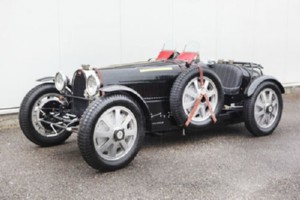 "1932" Bugatti Type 51 Pur Sang, Chassis 51127-R
"1932" Bugatti Type 51 Pur Sang, Chassis 51127-R
Jorge Anadon, owner and founder of “Pur Sang” in Argentina are specialist builders of recreation Bugatti's. Having started the company about 30 years ago and built the first Bugatti Type 35 re-productions in his house. Over the years when the company expended he started using the big sheds behind the house. He has now a company of more than 60 employees and manufacturers almost the total car in house. Pur Sang uses modern hi-tech to make the ultimate precision of each piece used in the Bugatti's combined with the craft man ship of every individual member of the team. A team dedicated to a perfect product. The chassis is handcrafted, so are the body parts and the engine after machined, put together by a team of father and two sons.
After assembling the engine the engine get fired up and tested till the team is satisfied that the engine can be installed into the waiting Bugatti. The factory has a design studio, engineering shop, body part shop, engine shop, spare part division, paint shop, everything required to make a perfect re-production. Pur Sang hasn't forgotten the little ones, they also hand made a reproduction of the Baby Bugatti (Type 52), and other models. Pur Sang has built a reputation of the perfect Bugatti re-production around the world. The clientele include well know people in the car industry and collectors of fine automobiles. If you always have dreamed to own a Bugatti and an original one is just out of your league, then this is undoubtedly the car for you.
This particular Argentinian “Pur Sang” recreation has been on display at the automobile Museum Stainz and is presented in exceptional condition throughout as the car has seen very limited to no use at all. The detail and the built quality of this car is simply phenomenal and it cannot easily be distinguished from the real car.
Following Bugattis are announced:
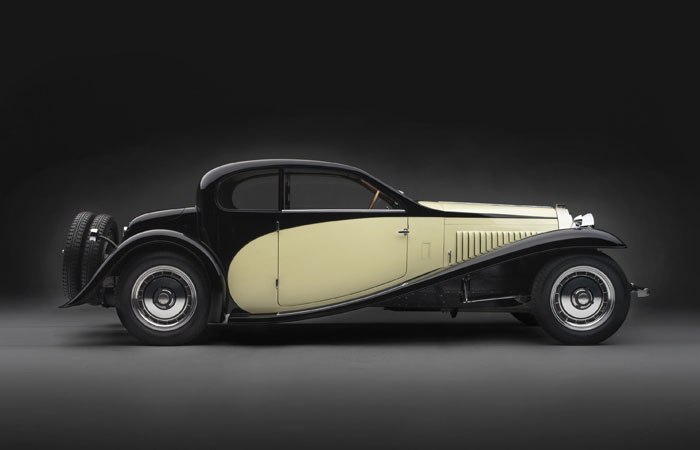
Including quite a few Bugattis!
More info about some of the cars
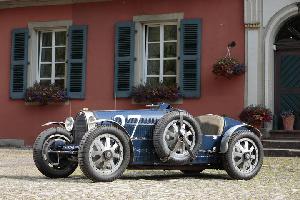
September 7, 2013 Bonhams Auction: Beaulieu, National Motor Museum Collectors' Motor Cars England
Lot 357: 1999 Pur Sang Type 35B
Chassis no. BC 122
Estimate:£60,000 - 80,000
The car arrived in the UK from Pur Sang's factory in November 2000 and in April 2002 was registered as road legal in this country. 'EX 9434' toured Switzerland throughout the summer of 2002 and in early 2003 underwent repairs to the chassis in Essen, Germany, while further maintenance was undertaken and a new radiator fitted in 2004/2005. For much of the last decade the Bugatti has been regularly used for events, shows and touring, including a tour of Greece and Southern Calabria in 2008. Described as in generally very good condition, the car is offered with current MoT and Swansea V5C registration document. The only declared fault concerns the starter motor. The car also comes with a specially made trailer to allow high speed towing of the car.
September 13-15, 2013 Bugatti Festival Molsheim France
As always organised by the Alsatian Bugatti club EBA, includes two trophees, the Trophée de la Fondation Bugatti, and the Trophée Lalique.
The presentation of all the Bugattis will be on the Sunday morning this year, in the parc des Jesuites.
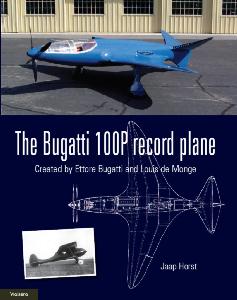 If you're interested in some reading; Jaap Horst will sell his book at the festival, especially on the sunday, though possibly on the saturday as well. The books he will be selling are the
If you're interested in some reading; Jaap Horst will sell his book at the festival, especially on the sunday, though possibly on the saturday as well. The books he will be selling are the

September 13-15, 2013 Presentation of 2 special Bugattis at Goodwood Revival England
Relaunch of Mme Itier´s Bugatti racer not seen out since 1937
This will be the first public appearance since 1937 of a once well known Bugatti Type 51 Grand Prix that was completely forgotten when it was pensioned off and rebodied into a sportscar – only to be rediscovered when restored and the full history was unravelled by French master historian, Pierre-Yves Laugier.
Goodwood Revival presentation
Now rebuilt and race ready in original form, this fascinating Grand Prix Bugatti will be presented first time out since the Swiss Grand Prix in 1937. The important relaunch takes place 13th–15th September at Goodwood Revival by the Credit Suisse rebuilt Race Control building.
Type 51A
41 Type 51 Bugattis were built, of which a handful were to 1.500 cc Type 51A specs. 80 years ago in 1933, French amateur racer, Anne C. Itier, ordered the T51A. To meet her order the Bugatti works selected a used T35 from the inventory and converted it to Type 51A specification giving it chassis number, 51142. With this car Mme Itier competed for 5 seasons in more than 30 events. Following the 1937 season the GP was pensioned off and rebuilt into a road going sportscar shortly before the war. A not uncommon practise for old racers that were either loved by their owners or still had enough quality for a second lease of life.
Discovery
Henrik Schou-Nielsen, present long term owner: “This Bugatti has proven to have a fascinating history, yet its racing past was forgotten with the passage of time. No one had paid much attention to old stories of an earlier lady owner - including myself!” But with research by ace historian, Pierre-Yves Laugier, it all became clear. It is therefore a great privilege to show Madame Itier´s old racer at Goodwood Revival. She even raced against a plane at Montlhéry so Goodwood with its aero and racing past is a fitting location. We are extremely grateful for being given this opportunity.
History tracing
Real progress was made some years ago when French Bugatti historian, Pierre Laugier, dived into his files and with archaeological expertise traced prewar photos, Molsheim factory records, and hard facts, as the car was stripped for restoration and unveiled its secrets. Amazingly the T51 turned roadster appears to have had only 5 registered owners, 2 of which were women, since ordered in 1933. It seems to have stayed in Paris till the late 50íes, when bought by a Dane.
Separated into 2 cars
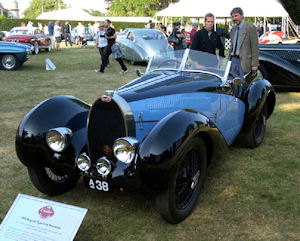 With its fascinating racing history we had to rebuild this historic Grand Prix car in its original form as owned and raced by Anne Cécile Itier. It is part of French Grand Prix history, and a most rewarding project. So the world was searched to complete the missing original parts. Meanwhile just as rewarding, was to reconstruct the roadster onto a new frame as this art deco roadster body was just too stunning not to be seen rolling again.
With its fascinating racing history we had to rebuild this historic Grand Prix car in its original form as owned and raced by Anne Cécile Itier. It is part of French Grand Prix history, and a most rewarding project. So the world was searched to complete the missing original parts. Meanwhile just as rewarding, was to reconstruct the roadster onto a new frame as this art deco roadster body was just too stunning not to be seen rolling again.
Presentation at Retromobile, Paris, now at Goodwood
Following the exhausting and meticulous restorations the roadster (on the right) was presented first time in 50 years in native Paris and later at Goodwood Cartier Concourse. Now, both cars will be seen together for the first time ever explaining the chronogical history. A unique event.
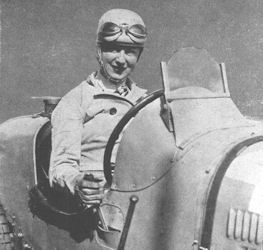
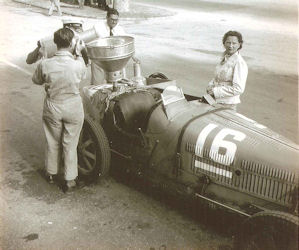
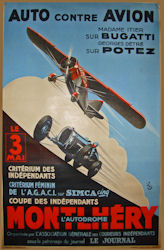
Anne C. Itier was the most active female racing amateur in France prewar. She did everything from front line Grand Prix racing, hill climbs, to rallies. She entered Le Mans 5 times - a female record, and did the Monte Carlo no less than 7 times. She knew celebrity racer, Hellé Nice, well. They raced alongside and shared the occasional event, such as the ´49 Monte Carlo.
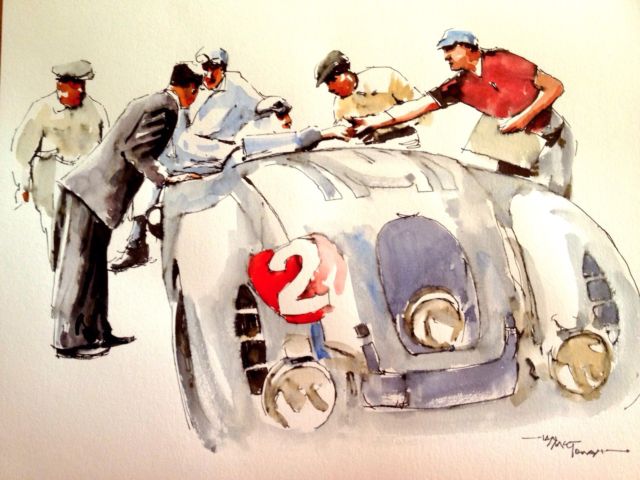
"Good Luck!"
By Ian McGowan
Thanks to Christophe Chanterault
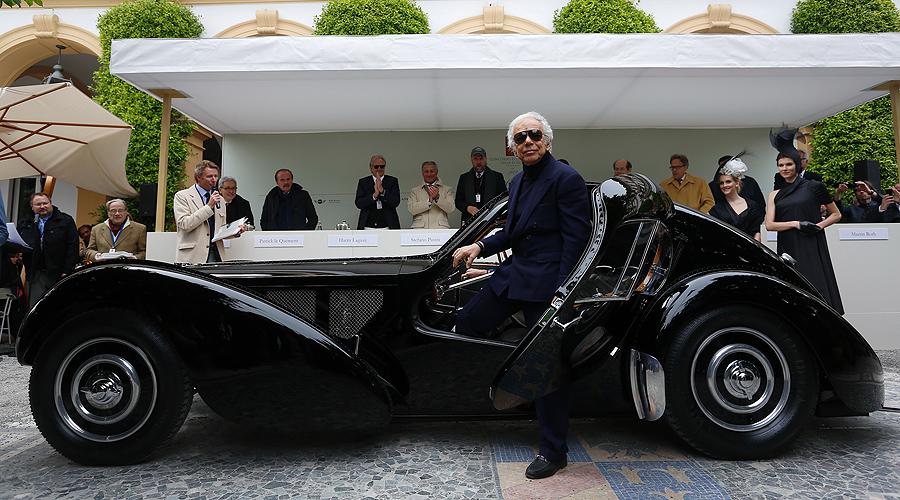
The elegant black coupé was the creation of Ettore Bugatti’s son Jean, and is today considered one of the most valuable cars in the world – indeed, it’s been the centrepiece of Ralph Lauren’s collection for some time now, the last of only four Atlantics ever built.
Ralph Lauren’s stunning Bugatti however won a 2nd prize at Villa d'Este: the prestigious Coppa d’Oro Villa d’Este, chosen by the people for the most beautiful vehicle.
The Bugatti 57SC Atlantic is officially the most expensive car in the world. And now the most highly prized.
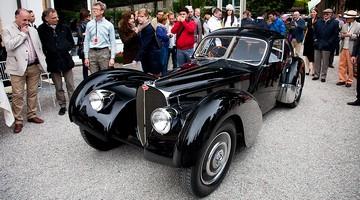



Dubai Police have revealed it is full-speed ahead for their supercar collection, which is about to get bigger - and faster.
A Bugatti is to be added to the force’s swanky sports car patrols, according to officials. The emirate’s cops are already the envy of petrolheads around the world as they can boast a Lamborghini Aventador, Ferrari FF, Mercedes SLS AMG, Bentley Continental JT, and Aston Martin One-77 in their garage - a collection they estimate is worth Dhs15 million.
An official at Dubai Police did not say which model of Bugatti they were after but the Veyron is the world’s fastest road car, capable of more than 400kph.
The Bugatti will be one of two new cars hitting the streets in the emirate soon, with more to follow. Speaking at the Arabian Travel Market in Dubai on Monday, where the force’s cars are on display until Thursday, General Khamis Mattar Al Muzaina, Deputy Director of Dubai Police, said the vehicles could help Dubai secure the winning bid to host the World Expo 2020.
“These cars are a marketing gesture for hosting Expo 2020 and show off our abilities,” he said.
Where do I sign up for the Dubai police force??

The cars, all selected from among vehicles that either did race or could have raced in the 24 editions of the Mille Miglia held from 1927 to 1957, had to perform dozens of time, speed and distance trials along the way. Mr. Tonconogy tallied 35,417 points, 576 more than the runners-up, Giordano Mozzi and Mark Gessler, in a 1933 Alfa Romeo 6C 1500 Gran Sport. That same Alfa had won the rally a year earlier, in the hands of a different team of Argentine drivers.
A 1933 Aston Martin Le Mans, driven by Giovanni Moceri and Tiberio Cavalleri, was third. Something of a surprise in fourth place was a 1933 Ford Model B roadster. One of just a handful of American cars entered, it was driven by Gianmario Fontanella of Italy, who finished just nine points ahead of the 1927 Bugatti T37 of Bruno and Carlo Ferrari.
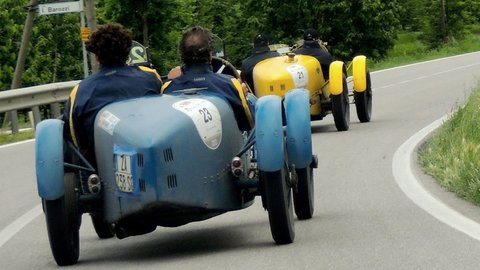
It is the fifth attempt by Mr. Tonconogy, 34, to win the rally, and he is now the youngest winner in the 31 years that the tribute rally version of the event has been staged. He is the developer of a winery, resort and spa in the Mendoza region of Argentina; he is also involved in his family’s business interests in Miami, according to published reports.
“I raced with the best co-pilot in the world,” Mr. Tonconogy said of Mr. Berisso on the victory podium. “We are extremely satisfied with the outcome reached, especially since this edition was packed with talented drivers and extremely competitive vehicles.”
The race has grown in recent years from something of a nostalgic, parochial remembrance for a bygone era of dubious street races to an international celebration of a golden era in automotive history.
Automakers supported the event — emptying out their museums in some instances — to help teams field cars. Among the manufacturer-backed participants were those driving entries from Alfa Romeo, Aston Martin, BMW, Bentley, Bugatti, Ferrari, Fiat, Jaguar, Lancia, Maserati, Mercedes-Benz and Porsche.
None of the race’s many celebrity participants — pro golfers, Olympic athletes, actors and actresses, auto executives and assorted executives — figured among the top finishers; most seemed to be, quite literally, just along for the ride. Scoring reasonably well among that group was the racer Andy Wallace in 137th place, the fashion model David Gandy in 169th and the businessman-racer Roger Penske in 202nd.
The race, organized this year by 1000 Miglia S.r.l., was plagued by almost constant rain, although no major incidents were reported. Worker and student demonstrations in Bologna — not rare occurrences — did little to disrupt the rally. It toured some areas in Emilia-Romagna that were particularly hard hit by a major earthquake that struck in the final hours of the 2012 event.
Of the record entry number, 340 were classified as finishers, even though more than a few had to be pushed across the finish line. The last stragglers did not arrive until the predawn hours on Sunday.
Top photo: Juan Tonconogy and his co-driver, Guillermo Berisso, streaked toward a Mille Miglia victory Saturday in a 1927 Bugatti T40.
Photo's: Jerry Garrett

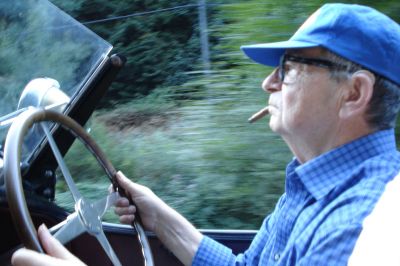 April 7, 2013
April 7, 2013 Xavier Feidt sent me the sad message on April 3 that, on that day, Jan Cohen had died in Alsace
Jan was one of the people who was already involved with Bugattis when they were still sold for scrap value, and was a very funny and pleasant character, always present at the Molsheim Festival though these last years he did not drive the whole rally anymore in the Type 43 which he owned since 1960, as age was beginning to show (his, not that of the Bugatti!). Jan even made jokes about the effects of old age. Read this article by Martijn Visser about a ride in his T43.
Jan lived alternatively in Amsterdam and with his girlfriend in Alsace, we hope he has a lot of fun with his T43 on the mountain roads in Heaven. We wish all who loved him, but especially Doris a lot of strength to cope with this loss.
 March 26, 2013
March 26, 2013 The sales of the Bugatti super sportscars has dropped this past year. In 2011 the VW-daughter sold 38 cars, the past year these were only thirtyone.
On the largest and most important markets the Bugatti-buyers were less interested. The number of registration in Europe dropped from 18 to 12, with the German market particularly bad with 2 sales instead of the 5 of the year before.
North-America was good for Bugatti (USA that is, no sales for Canada or Mexico) where sales rose from 7 to 10. In Asia 2 Grand Sports were sold, 2 less than in 2011. No sales at all to China in 2012.
Bugatti will build a total of 150 of the 2 million euro Grand Sport, including the Vitesse. Not all 150 have been sold yet, the expectation is that the car will be sold until 2015.
Info and Photo: De telegraaf - Autovisie
March 5, 2013
 Wolfsburg/Molsheim, February 26, 2013 – Manuela Hoehne has been appointed spokesperson for the Bugatti brand as of 1 March 2013. In her new role as Head of Media Relations she follows on from Emanuela Wilm, who will be taking on responsibilities as General Manager Marketing, Events and Customer Relationship Management for Bugatti in the USA from 1 April 2013. “Manuela Hoehne is a proven expert in communications for the automotive and luxury goods sectors, and we are very glad that she will be joining us at Bugatti,” commented Wolfgang Glabus, Director of Communications at Bugatti.
Wolfsburg/Molsheim, February 26, 2013 – Manuela Hoehne has been appointed spokesperson for the Bugatti brand as of 1 March 2013. In her new role as Head of Media Relations she follows on from Emanuela Wilm, who will be taking on responsibilities as General Manager Marketing, Events and Customer Relationship Management for Bugatti in the USA from 1 April 2013. “Manuela Hoehne is a proven expert in communications for the automotive and luxury goods sectors, and we are very glad that she will be joining us at Bugatti,” commented Wolfgang Glabus, Director of Communications at Bugatti.
For more than four years Manuela Hoehne has been Communications and PR Manager for Europe at the British sports car manufacturer Aston Martin Lagonda Ltd. From 2000 to 2007 she worked as a press officer for the German Association of the Automotive Industry (VDA) in Frankfurt and Berlin.
In her new role, Manuela Hoehne will be in charge of global communications at Bugatti. She reports directly to Wolfgang Glabus. Emanuela Wilm has been Head of Media Relations since 2008.
During her time in the role, the Bugatti Veyron Grand Sport, Super Sport and Vitesse have undergone successful market launches.

Like many of you, we’ve been curious about the progress of the incredible Bugatti Type 64 coachwork project undertaken by Oxnard, California’s Mullin Automotive Museum. For those readers who may have missed its initial unveiling at The Quail, A Motorsports Gathering, during the August 2012 Pebble Beach week, here’s some background, courtesy of the Museum:
First designed in 1939 by revered designer and engineer Jean Bugatti, Chassis #64002 was never finished due to Bugatti’s tragic death during the road test of a Bugatti Type 57. After years of extensive research, planning and coachwork build, August 17 will mark the first time in history Jean Bugatti’s final chassis will wear a streamlined, handcrafted body, a vision left unfulfilled for 73 years.
Created in collaboration with the Mullin Automotive Museum, Stewart Reed Design and Automobile Metal Shaping Company, the new body will pay homage to Jean Bugatti’s original concept. The hand-formed body, crafted using many of the same coachbuilding techniques employed in 1939, will feature numerous original styling cues including iconic papillion doors and an intricate riveted body structure.
We recently spoke with Webb Farrer, director of restorations and logistics for the Mullin Automotive Museum, who shared numerous photos and some insight into the car’s current state, and how it will appear when it’s completed. “The idea behind this project was that we’ll show people how coachwork was done in that period; the entire project has been done in period style,” Webb explained. “These days, they design bodies with foam core, which they shave to make the shapes that the panels are formed over. Back in the 1930s, this was done off of a wooden buck.
“We’re not going to primer or paint this car,” he said. “The body will be in the original, hand-pounded aluminum finish. There will be weld lines and hammer marks – you’ll see the building scars, just as it would have looked back in the day, prior to being painted.
Those amazing doors have given the build team some long nights. “People think of those doors as gullwing doors, but Bugatti actually named them ‘papillon,’ which means butterfly. He designed those doors about 15 years prior to Mercedes-Benz making the ‘Gullwing’ SL, so although people think of Mercedes-Benz as the first to use that style door, it’s not the case,” Webb said. “They’ve been a huge challenge. We’ve refined the doors, and now they’re swinging with the hinges, and have the proper shocks so that they will stay open. They now work beautifully.
“We’ve got all of the body panels completed, and are in the final stages of fitting the hood. It will clamshell right into the shape of the radiator – it’ll be very reminiscent of the Type 57. The taillamps and headlamps will all function, everything will work. And we won’t be putting a full interior in it; there will be a driver’s seat, which is a period-style seat. You won’t see leather or wood inside – it will all be aluminum, and will be finished to the highest standard. You’ll be able to see all of the lightening holes in the inner structure, which is very technical and quite beautiful in itself. The attention to detail on the interior will be incredible.”
The team has planned for a very unique method of displaying the Type 64; the body will be fully removable from the rolling chassis, in a matter of 15 minutes, and will sit on a stand so that both it and the fully finished chassis – with its single downdraft-carbureted 3.3-liter straight-eight engine – can be admired independently. “At The Quail last summer, it was far from completed, but we had the body bolted onto the chassis, and we drove it on and off of the field. We’ve proven that we can do it,” Webb smiles. “We’re confident that we will be able to put the body on the chassis and drive it 30 miles, if we want to.
“We’re now in the middle of February, and I would think that by the middle of April, we should have the car at the Museum. Our goal is that it will be a learning tool, so we’ll have the wooden buck on display next to the body and chassis. It will be a progression: buck, body, chassis. Mr. Mullin can’t wait to share this learning tool of how this process was done in the 1930s. He’s very excited about sharing this with the public at the Museum, as is everybody who’s involved in it.”
First published in: hemmings.com, Photos courtesy of Webb Ferrer and Mike Kleeves.
Wolfgang Dürheimer Interview: Joining Audi and the Future of Bentley and Bugatti
C/D: Tell us a bit about your plans at Bugatti. Will the next Veyron be first, or the Galibier four-door sedan?
WD: The successor of the Veyron will likely be the first car to market, but it is not decided yet. Both projects are pursued with high energy. A Bugatti is like a work of art: It doesn’t follow a standard life cycle, but is finished when the artist has signed it off.
C/D: What kind of car will the Galibier be?
WD: Simply the best luxury sedan in the world, the most beautiful large four-door in the world, powered by a 16-cylinder engine with over 1000 hp, and faster than anything on the market. And that includes tuning cars, which now stand at around 235 mph. And I can assure you that we will include a few innovative ideas that are a first in the automotive business as a whole. I thought I had seen everything after 10 years at the top of Porsche’s R&D. I was wrong.
C/D: Will the Galibier come as a hybrid?
WD: It is an option, but it hasn’t been decided yet. We have to watch the politics. We want our customers to be able to drive to the doorstep of the finest hotel in a city with their Galibier, not with a taxi. So if the inner cities are shut off to conventionally powered cars, the Galibier will come as a hybrid; two powertrain options are possible. But right now, the priority is sheer power, not a hybrid.
C/D: Generally speaking, what is your assessment of hybrids and electrics?
WD: I don’t view hybrids as a transitional technology. They will be with us for a long time. As to electrics, the topic has been somewhat deflated. We are in command of the motors, we master the electric management, but battery technology still cannot deliver. Weight and cost are the killers. The researchers are working hard, but they have been for the past 30 years. They say a breakthrough is possible, and we have also heard that for many years. In my entire time at Porsche, I have not seen the need to do a fully electric car, and I am not supportive of an electric racing series, either.
Bonhams Auction, Les Grandes Marques du Monde au Grand Palais, Paris, February 7, 2013 :
1931 Bugatti Type 54 Grand Prix Châssis #54201, Engine #1, Not Sold (highest bid €2.000.000)
1938 Bugatti Type 57C Coupé ex-Ettore Bugatti Châssis #57335, Sold for €690,000
Artcurial Auctions, "Motorcars à Rétromobile", Paris, February 8, 2013 :
Lot 169: Bugatti 'Baby' Châssis No.430A, Sold for €63,754
Lot 364: 1936 BUGATTI 57 C VENTOUX, Châssis No.57452/57308, Sold for €421,445
Lot 367: 1935 BUGATTI TYPE 57 CABRIOLET VANVOOREN Chassis No. 57274, Moteur No.197, Sold for €586,112
Lot 391: 1995 BUGATTI EB 110 SS Châssis n°ZA9CBO2U5RCD39025, Sold for €448,890
Lot 392: 1935 BUGATTI TYPE 57 COACH VENTOUX Châssis 57344, Moteur 265, Sold for €403,149
Thanks to Christophe Chanterault

At the last day of Retromobile, a great discovery was made, the first Prototype for the Bugatti Veyron!
As we can see, the prototype already showed a lot of similarities with the final design of the Veyron,
but was declined because it looked a bit too much like one of Volkswagen's earlier designs...
Photo provided by Federico Göttsche Bebert with the title: If the Veyron had been built in 1947.
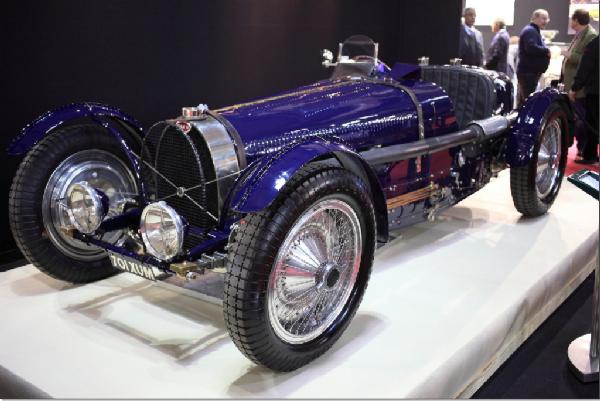
Molsheim/Paris, 06 February 2013 – With the chassis of one of the first three Type 59 Bugatti Automobiles celebrates the 80th anniversary of this legendary model.
The Salon Rétromobile takes place from February 6th to 10th in Paris and is one of the world’s most prestigious collector cars exhibitions bringing together collectors, dealers, brand representatives, auctioneers and enthusiasts from all over the world. For the third time Bugatti Automobiles and Bentley Motors join forces and welcome customers and VIPs in a lounge, in which each of them are showing a historic masterpiece of their brand.
The first three Type 59 race cars had been built in 1933. The chassis on display at the Rétromobile is one of these first three cars and was referred to in the Molsheim factory books as ‘Voiture Moteur No. 3’ (‘car engine number 3’). The Bugatti Team’s debut of the Type 59 took place at the Spanish Grand Prix at San Sebastian in September 1933 where they participated with three cars. This exhibited chassis was registered in the name of Ettore Bugatti Automobiles with the number 4619 NV 2.
It was participating in race No. 26 and driven by René Dreyfus who finished in 6th place. From 1934 onwards Grand Prix race cars were only allowed to weigh up to 750 kg, with the result that the three Bugatti Type 59 were overweight and had to be modified. They got large holes in their chassis frame side members to shed some weight. These modifications have even been put on record in the factory books. The engines were also upgraded from the original 2.8 litre capacity to 3.3 litres by fitting the 100mm stroke crankshaft of the newly introduced Type 57 in the same year. In 1934 the exhibited chassis entered its first Grand Prix of the season, the Monaco GP together with three further Type 59. ‘Moteur No. 3’ was still in 2.8 litre disguise and was allocated to Robert Benoist. He had been the fastest in training, but damaged the car and could not take part in the race. After the car was repaired in Molsheim, it was kept as a spare car and finally sold together with the other three Type 59 race cars to a quartet of British amateur racing drivers: Earl Howe, Brian Lewis, Lindsay Eccles and C.E.C. Charlie Martin. These cars were later known as the "four English Type 59s" and had received the chassis numbers 59121, 59122, 59123 and 59124. The price was the at that time enormous sum of 220.000 FF, almost double the price of a Type 35B. The car on the stand carries the chassis number 59121. After having been in several hands in the UK it has been bought in 1949 by the passionate Bugatti collector Stafford East from the UK who kept the car for 56 years. In 2005 it was sold at Bonham’s Goodwood auction to its present owner, who himself played a major role in Bugatti’s recent history.

This is the fascinating history of a once well known Bugatti Type 51 Grand Prix car that became completely forgotten when it was pensioned off and rebodied into a sportscar – only to be rediscovered in recent years when restored and the full history was unravelled by French master historian, Pierre-Yves Laugier.
Mystery roadster
Yet this stunning roadster remains a mystery as the body builder and the exact details of the rebodying is still not known in detail, and this is why it will be shown at Retromobile - first time out after 50 years – as a challenge to provide the last pieces of the puzzle.
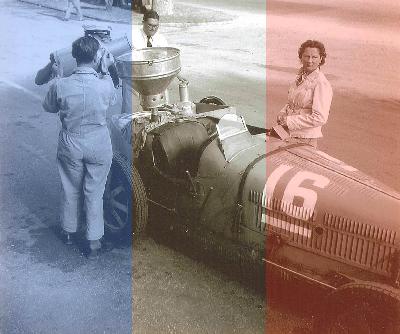 Type 51A
Type 51A
The car was originally ordered by French amateur racer, Mme Anne C. Itier, who competed in more than 30 events with it in Type 51A 1.500 cc Voiturette form (photo on the right), Following the 1937 season the GP was pensioned off and rebuilt into a road going sportscar shortly before the war. A not uncommon practise for old racers, that were either loved by their owners or still had enough quality for a second lease of life.
Amazingly the T51 turned roadster appears only to have had 5 registered owners, of which 2 were women, since it was ordered at the Bugatti works in early 1933 by Mme Itier and appears to have stayed in Paris till the late 50íes.
Discovery
Henrik Schou-Nielsen, present long term owner: “It has a fascinating history. When I bought the roadster 17 years ago, no one was sure what it was. It was not quite a barnfind, as it had languished in a private collection for over 30 years, but apparently no one had taken much notice of the Bugatti – including myself – it did, however, stay in the back of my mind for some 20 years after I visited the collection in 1977!”
History tracing
Gradually the jig-saw came together, but real progress was only made a few years ago when Pierre Laugier dug deep into his files and with archaeological expertise traced prewar photos, Molsheim factory records, and hard facts, as the car was stripped for restoration and suddenly unveiled its secrets.
Separated into 2 cars
With fascinating projects like these, there is only one way – the proper way! We just had to rebuild this historic T51 Grand Prix car originally ordered by well known French amateur racer, Anne Cécile Itier. It is part of French Grand Prix history, and what a rewarding project. Meanwhile just as rewarding, was to rebuild or reconstruct the “mystery roadster” onto a new frame as the flamboyant art deco roadster was just too stunning not to be seen rolling again.
Presentation
So this is what you will see at Retromobile this year from 6th -10th February. The first presentation of the “Mystery Roadster”, also nicknamed the Honeymoon Roadster. A car which takes to the roads again for the first time in 50 years this January.
The car will be presented at Retromobile on the PreWarCar.com stand at an informal unveiling for press and friends at 11.00 am. Wednesday 6th Feb.
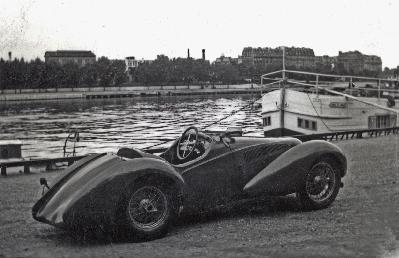 Top of this article: The Bugatti in Denmark, 1962
Top of this article: The Bugatti in Denmark, 1962
On the right; the car on the border of the Seine, 1951
By
Henrik Schou-Nielsen, owner
Joris Bergsma, PWC Publishing, BV
Where
PreWarCar.com, Show stand no. G38
When
Wednesday 6th 11.00 am.
Partners:
Ivan Dutton Ltd, Rebuilt and transport
Keith Pointing, Final finishing and preparation
Anne C. Itier was the most active female racing amateur in France prewar. She did everything from front line Grand Prix racing, hill climbs, to rallies. She entered Le Mans 5 times - a female record, and did the Monte Carlo no less than 7 times. She knew celebrity racer, Hellé Nice well. They raced alongside and shared the occasional event, such as the ´49 Monte Carlo.

From the National Post, January 25, by David Grainger
The project was to recreate the famous Bugatti coachwork created for the Paris Autoshow in 1935 and place it on an original Type 57 Bugatti chassis with matching engine, transmission and rear axle. The original car, called the Aerolithe (translates into sky stone or meteorite), disappeared not long after its appearance in London in 1936. What happened to it is a great mystery and one likely never to be solved. It was likely broken up by the factory in the pursuit of spare parts or sent to scrap during the war by the Germans, who held the Bugatti factories, but not a trace of it has ever been found.
There were plenty of rumours, such as a GI bringing it back to New Jersey after the war, but there have never been any records to back up this or any other mythical fate.
My fascination for the car began in the late 1990s when I purchased a large number of original Bugatti parts for a client, most of them Grand Prix car bits and pieces, but along with those were the original and virtually complete chassis and parts for a standard Type 57.
I tinkered with the idea of building several different styles of car on this chassis, but the one that kept coming back to mind was the fabulous Jean Bugatti-designed streamliner, the Aerolithe. It was the prototypical car for the three Bugatti Atlantics that followed, and influenced coach builders around the world.
One of the Atlantics recently sold for $35-million and is on display at the Mullins Museum in California. Another is owned by designer Ralph Lauren and a third was destroyed in a train crash many years ago has been rebuilt using what are said to be original parts from the train-wrecked car. Its originality and claim to be the third Atlantic is controversial, but I saw the car at Pebble Beach and, controversy aside, it is a wonderful automobile. I do wonder about its restorer’s colour choice, however, as it was painted a dull battleship grey.
I had several people wanting to sponsor the Aerolithe build, among them Nicolas Cage, who approached me about it a couple of times. To tell you the truth, I would have loved to build it with him, as he is a real dyed-in-the-wool car nut and I bet you he would have been a regular on Sunset driving this thing. Mind you, as it turned out, I doubt he could have afforded it.
One gentleman did step up, and I am glad he did because he really understood the importance of recreating the car exactly as it would have been built in 1935. I cannot name him, but he has remained steadfast throughout the whole exhausting and troublesome process and never advocated cutting corners even when asked if it meant compromising the historical accuracy of the completed car.
The original challenge was this: Only 11 useful photographs of the car existed, although we came across two more during the course of the build. None show the interior in any detail and none show the car with an open hood, although you can see parts of the engine through the cooling screens in the hood sides. We had to build the car to be absolutely accurate to the methods and materials that would have been used on the original, which meant exhaustive research into every kind of fastener, clip, nut, bolt and screw that were going into the car. We borrowed information from the Bugatti Atlantiques, but had to constantly remember that the Aerolithe came first and was not as a sophisticated car, so we also had to study cars made in the two-year period before the 1935 Paris Auto Show.
The handful of photographs we enhanced with computers ferreted out a lot of information that was previously unpublished.
Of course, when I mentioned in the Bugatti Club publication in England what we were discovering, it started a storm of controversy. Much of it was amusing and some was a bit annoying.
Over the build, we have amassed a huge amount of engineering detail and we are pretty sure we know exactly how the original car was built and on what kind of chassis.
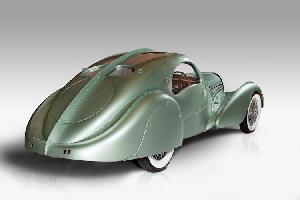 For the past year, the car has been the definition of two steps forward and one step back. Sometimes it was even one forward and one back. Small problems niggled almost constantly and the magnesium we used to create its wonderful contours was always willing to give us a hard time and, in fact, still does, even though the car is complete.
For the past year, the car has been the definition of two steps forward and one step back. Sometimes it was even one forward and one back. Small problems niggled almost constantly and the magnesium we used to create its wonderful contours was always willing to give us a hard time and, in fact, still does, even though the car is complete.
A real irritation throughout the process was with parts we sent out of for nickel plating. These were often ruined by the Canadian plating company we contracted. In the end, we had to send all the parts to the U.S. to have them redone properly. That was a shame because I like to keep my projects local and all-Canadian. To that point, the Type 59 Bugatti Grand Prix I built a few years ago has “Made in Canada” stamped into a very secret spot, a proof of manufacture in case a greedy owner tries to pass it off as an original factory-built car. Proper due diligence will, no doubt, reveal the stamp.
As the original Aerolithe was claimed by Bugatti to be built from electron, a magnesium alloy, and the press of the day christened it the Electron Coupe, it was decided early on to build the body from that material. While it was not a mistake, it certainly was a challenge. Magnesium is a temperamental and unforgiving material to use and it challenged us and often frustrated us from the beginning. Over the years, however, we have almost tamed it and the car’s coachwork is almost completely handcrafted from electron so can truly be called the Electron Coupe.
We recently finally called the project finished and a professional photographer shot it for us. At one point, he turned to me and asked, “You made this?” Until that moment, it hadn’t really sunk in, but, yes, I guess I did. Mind you it was with an incredible team of craftsmen who I have the honour to have work for me and with the unwavering dedication to the project of its patron.
It was supposed to make its international debut as the feature car at the Concours d’Elegance in Kuwait City, Kuwait, but tensions in the area have seen the concours postponed until 2014. That is too bad, however, there is no end to the prestigious shows that would like to see the car on their display. There is still a good chance the car will travel to the Middle East for a special museum showcase, but for the present, we will have to see where the Aerolithe’s official coming out is going to be staged. For now it lives with me.
Scottsdale Collector Car Auction - Barrett-Jackson Salon Collection Scottsdale, January 13-20, 2013 :
1927 Bugatti Type 38 Four-Seat Open Tourer, Châssis #38243, Engine #135, Sold for $715,000
Bonhams Auction, The Scottsdale Auction, Exceptional Motor Cars, January 17, 2013 :
1930 Bugatti Type 46 Faux Cabriolet Veth en Zoon of Arnhem #46293, Sold for $951,000
Gooding & Company, The Scottsdale Auction, January 18-19th, 2013 :
1938 Bugatti Type 57C Atalante #57766, Engine #57C, Sold for $2,035,000
1936 Bugatti Type 57 Ventoux #57345, Engine #282, Sold for $451,000
Thanks to Christophe Chanterault
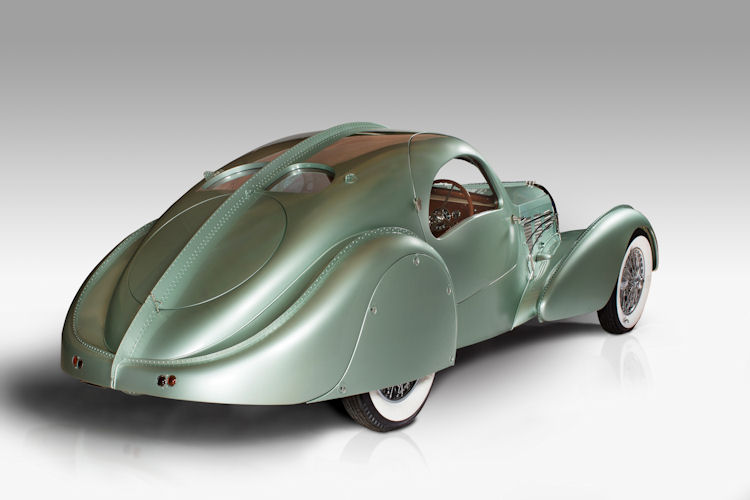
I have been writing about the build of the Aerolithe by the Guild of Automotive Restorers in Canada various times on these pages (see the News Archive and the Bugatti Revue); it is now finally ready! See the fabulous shape of this breathtaking automobile in the image above. The recreation was build using magnesium sheet on the earliest Type 57 chassis known to exist, 57104
During the build the original, as presented at the 1935 Paris Motor Show, was extensively studied by experts of the Guild. All known photographs were viewed as to all possible details, including the lights and seats. There has also been a lot of dispute with Bugatti experts from all over the world, over details like the shape of the chassis used for the original Aerolithe, a regular T57 chassis or a special intermediate prototype chassis, from before the T57S. Dispute will probably also continue over this recreation, though I'm sure that everybody must admit that de Guild did a fantastic job to recreate into the smallest detail what can be easily recognised to be the most spectacular automobile design of all time, and thus honoured the car's designer Jean Bugatti.
The Guild built the Aerolithe in a specific version, as presented in the 1935 Paris motorshow. Later photographs show some modifications, like the addition of sidelights and windscreen wipers, which were omitted on this recreation also.
It is not known yet when this fantastic automobile will be presented to the public, imagine a display where this prototype will be presented alongside the "production" Aero, the ex-Williamson Atlantic (chassis 57374). Like two metallic spaceships!
At that time, also all the details which were found during the research will be presented.
I think we can all congratulate David Grainger and his team with this fantastic feat!
Go to the builder's website: www.guildclassiccars.com

Geo Ham - Robert Benoist sur une Bugatti
Until end of July, 2013 Mulhouse + Reserve exhibition Kassel, Germany
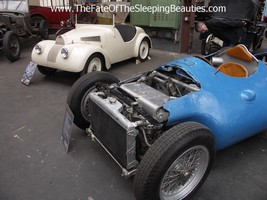
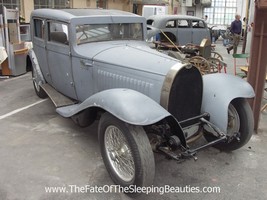
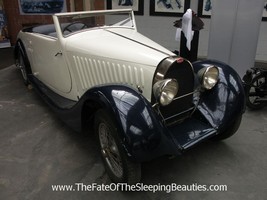
from now on until end of July, 40 cars from the reserve of the Schlumpf museum in Mulhouse are on public display in the German city of Kassel. Among many other rare cars in any status of decay, there are seven Bugattis in the exhibition :
1. Type 68B
2. Type 251
3. Chassis 57618 (ex-Shakespeare)
4. Chassis 57265/57191
5. 44664 torpedo
6. 46555 Convertible by Dolce, Cannes
7. 46552 (ex 46549) ambulance
The exhibition in an old factory hall is a great experience (not only because of the Bugattis) and I can only encourage all of you to take a visit.
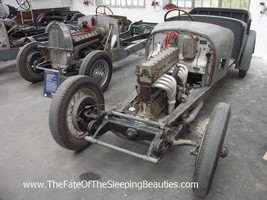
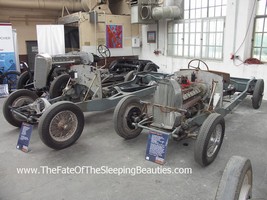
The address is:
Unternehmenspark Kassel
Tor 1 / Halle 19
Lilienthalstrasse 25
34123 Kassel
Germany
www.schlafende-automobilschoenheiten.de
The opening times are:
Monday: closed
Tuesday-Friday: 11-19 h
Saturday-Sunday: 10-19 h
Public holidays: open
Admission 8 Euro.
May 11 - June 15, 2013 Historical, Vintage and Classic Cars Museum Kuwait city
1st exhibition of the "Canadian" Bugatti T57 Aerolithe replica
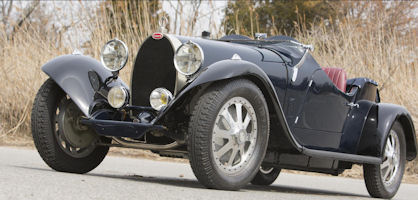
June 2, 2013 Bonhams Greenwich Concours d'Elegance Auction UK
Lot 324: 1930 Bugatti Type 43 Supercharged Sports 2/4 Seater Chassis no. 43286, Engine no. 133
Estimate: US$ 1 million/1.2 million - £660,000/790,000 - €770,000/930,000
This is an exquisite supercharged 8-cylinder Bugatti. It is a car that has been fastidiously researched by two of the great authorities on the marque, David Sewell in the UK and Pierre-Yves Laugier of France, and one that has benefited from a comprehensive restoration at the hands of one of the great restorers of the marque, Jim Stranberg of High Mountain Classics in Colorado.
Its documented history, compiled from the reports of these two renowned historians, has been traced back through a combination of factory records and French registration listings which actually begin on September 1928, when the car's engine '133' was built at the Molsheim Works and fitted to chassis 43286. It was one of eight cars to be built that month. It would not be sold from the Works, though, for another 18 months, when it was invoiced to B. Larrousé of Paris on May 12, 1930. Sewell's belief is that Larrousé was most likely a recently appointed agent for the company as just three were sold to him in 1929 and no less than 56 Bugattis were invoiced in 1930!
Through Laugier's forensic style investigation of the French registration records it was established that, while the first person that Larrouse sold the Bugatti to is not confirmed, by 1932 it was the property of M. Eonnet. The Eonnet family was known to have been serial Bugattistes and would follow this purchase with acquisitions of other Bugattis including a 57S (57511) and a Type 51. Photos sourced from the family album by Laugier show the 43 being enjoyed by Eonnet, and establish that it carried factory Grand Sport coachwork.
In 1936 the car moved to the first of a series of owners on the French Riviera and received a new local registration with the Nice authorities. Amazingly and helpfully these police records exist, and refer back to the car's last change of ownership as having been in July 1933 in Paris. The Bugatti would pass through the hands of custodians in Nice, Cannes, Avignon and finally back to the coast of Marseille in September 1948.
Within 2 weeks, the car was bought in Marseille by American Peter Hall and this would commence its U.S. history. Two years later he shipped the Bugatti back to America in 1950. By this time, the car was already in the guise in which it is seen today, as a typically mid-1930s 2/4 Seater with full fenders and with two raised cowls. Neither Sewell nor Laugier have pinpointed a precise date when the car was updated to this style, but both surmise that its revisions would have made the car look more like the contemporary Type 55 and other European Sportscars of the day which were carried out during its time on the French Riviera. Although this work has long been attributed to Paris coachbuilder Million-Guiet, it seems unlikely.
Over the course of the last 60 or so years, the car has had just a handful of owners: Ralph Eades of Santa Ana, CA, in 1953, who is known to have purchased it from Peter Hall, then onto Tom Harrison in 1973. After, it would pass into the long term ownership of then American Bugatti Club President and noted Bugatti collector Richard Adams of La Mesa and, subsequently, family members Lee Adams and Betsy Adams.
Within the last decade, the Adams decided to restore the car, commissioning Jim Stranberg of High Mountain Classics to undertake this work. A comprehensive restoration of cosmetic and mechanical aspects has produced the stunning result that we see today.
On completion of the restoration, the Type 43 made its debut on the hallowed fairway at the Pebble Beach Concours in 2006, where it received 3rd in its class behind a somewhat formidable entry - a considerable achievement. Since then it has changed hands twice and has continued to be shown, most recently at 'The Elegance at Hershey' Concours in June 2011 where it was awarded the 'French Curves' award, confirming that the Bugatti maintains the exceptional condition achieved in its restoration.
It could be argued that a Type 43 is one of the best ways to experience the Bugatti legend, as it harnesses the 'pur sang' or 'pure blood' of the fabled Supercharged Type 35B. With virtually the same running gear, yet in an altogether more road friendly package, it is more suitable for high speed touring. As they go, this is surely one of the best presented examples of its kind and is in ready to be used order.
Today, by virtue of the considerable number of endurance races that Bugatti's Type 43 contested in period, the cars are now eligible for many of the more desirable retrospective events including the Mille Miglia and Le Mans Classic.
With a top level restoration under its belt, this stunning Bugatti would be at home on the road, track or concours field.
- Lot 212: 1938 BUGATTI TYPE 57 COACH VENTOUX, Châssis 57704, Moteur 503, Collection André Lecoq, Estimation: 250000 - 350000 €
Info 57704
- Lot 256: 1938 BUGATTI TYPE 57 COACH VENTOUX, Châssis 57634, Moteur 335, Estimation: 250000 - 300000 € :
Info 57634
- Lot 257: 1935 BUGATTI TYPE 57 COUPE GANGLOFF, Châssis : 57250, Moteur : 59294/141, Estimation: 500000 - 700000 €
Info 57250
More info www.artcurial.com

June 21 - 23, 2013 90th anniversary of the Tours Grand Prix Tours, France
More info www.grandprixdetours.com
A series of articles on the 1923 Tours Grand Prix at www.velocetoday.com
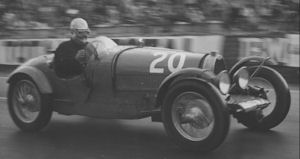 June 23, 2013 Osenat Auction Paris France
June 23, 2013 Osenat Auction Paris France
On Sale: 1929 Bugatti T37, chassis 37363
Estimate 450,000 - 600,000 euro
Complete history since new
More info www.osenat.fr

Includes Cartier 'Style et Luxe' display
Goodwood has announced some of the exceptional cars that will grace the lawns of Goodwood House during thw Festival of Speed from July 11-14.
The acclaimed celebration of fine automotive design that is the Cartier 'Style et Luxe' concours d'élégance has become one of the festival's myriad "must see" attractions.
Now in its 19th consecutive year, the Cartier 'Style et Luxe' has gathered hundreds of the world's finest, most beautiful, valuable, distinctive and sought-after cars, all competing for the coveted Overall Winner award, as voted for by a distinguished panel of judges.
This year's gathering will, if anything, be even more exceptional as Goodwood celebrates the 20th anniversary of the Festival of Speed. In line with the 2013 theme of "Best of the first 20 years", the eight vehicle classes and cars on display at Goodwood will reflect many of the greatest machines that have graced the tranquil Cartier Lawn over the last two decades.
There will be about 50 cars on display this year, as well as one spectacular beast only seen at Goodwood once before. Entries already confirmed include the stunning 1929 Bugatti Type 41 Royale with Coupe de Ville coachwork by Binder, as well as an unusual coachbuilt Vauxhall 30/98, to help mark the centenary of Britain's 100mph car.
An array of pre-Second World War streamlined automotive art will include a beautiful 1938 Bugatti Type 57S Atlantic. The beast referred to above is the one-off Phantom Corsair that first came to Goodwood in 2006, when it proceeded to gently move across the Cartier lawn by itself in the middle of the night with the engine off, the car in gear, and the handbrake firmly applied.
August 2 -4, 2013 Classic Days Schloss Dyck Germany
Including "Jewel in the Park" concours and "Racing Legends" event with special Bugatti celebration
The Concorso d’Eleganza Villa d’Este 2013 will be staged on the weekend of 24-26 May over the grounds of the Grand Hotel Villa d’Este and neighboring Villa Erba on Lake Como in Cernobbio, Italy.
The 2013 edition of the Villa d’Este Concours d’Elegance will again see an intimate selection of classic automobiles displayed against the stunning backdrop of Lake Como. First held at the same location in 1929, this year’s event will see an extensive programme throughout the weekend, maintaining an ambience for those involved but at the same time offering the wider public a chance to experience the ‘Classic Weekend’ on Lake Como in the company of classic car and motorcycle enthusiasts.
Now under the patronage of the BMW Group, Concorso d’Eleganza Villa d’Este has been held each May since 1999 on the grounds of the Grand Hotel Villa d’Este on the Saturday, while the adjacent parkland of Villa Erba will open its gates to all car and motorcycle aficionados on the Friday evening for an open-air cinema, and on the Saturday and Sunday for the Public Days.
The heart of the Concorso d’Eleganza remains at the Grand Hotel Villa d’Este where beautiful and rare examples of the automotive art seek the favour of the invited guests and the jury. In 2013 some 52 select cars will be entered in competition, including the following Bugatti:
1938 Bugatti Type 57SC Atlantic – Known as the ‘Atlantic’, the Bugatti Type 57SC is not only one of the world’s rarest and most valuable cars, but also one of the most visually beguiling. Only four examples of this automobile were built between 1937 and 1938 at the legendary factory in the Alsace. The “masterpiece” of Jean Bugatti, son of company founder Ettore Bugatti, is blessed with both breathtaking design and extraordinary engineering. The Atlantic set to go on show at the 2013 Villa d’Este Concours d’Elegance dates from 1938 and is number four in the production run. It is in original condition and can already look back on a successful career in automotive beauty pageants around the world.
RM Auctions will once again be a guest at the Concorso d’Eleganza Villa d’Este in 2013. Some 45 top-class cars will go under the hammer on Saturday evening at Villa Erba. This auction will begin at 8.00 p.m. and again feature special models, such as a Bugatti Type 46 Superprofile Coupe and a Ferrari 340/375 MM.
1930 Bugatti Type 46 Coupé Superprofilée #46208, Engine #77
1927 Bugatti Type 37 Grand Prix #37254, Engine #207
1929 Bugatti Type 40 Roadster #40845, Engine #769
1937 Bugatti Type 57 Ventoux #57524, Engine #379
More info www.rmauctions.com
This year's theme “Automobiles Masterpieces” with eg. Bugatti T57 C uit 1939 Gangloff in Saoutchik style.
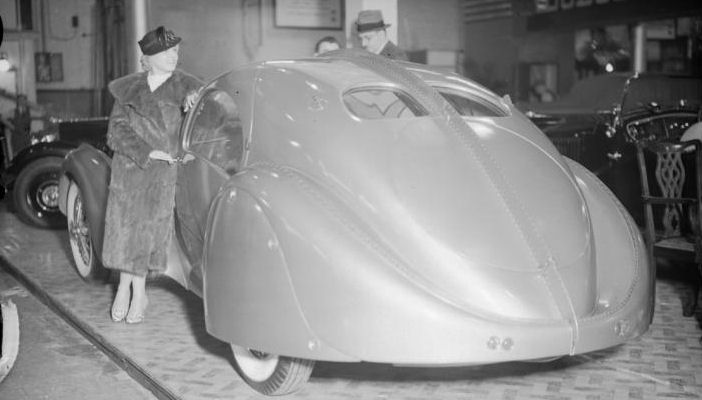
Streamlined car on display at a motor exhibition, Olympia
This photo was found by Anton van Luijk in the Daily Herald Archive, on the English www.nationalmediamuseum.org.uk website.
Of course it depicts the type 57 Aerolithe at the London Motor Show, and is a photograph which even the guys of the
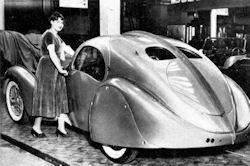 "Guild of Automotive Restorers", who recently presented the recreation of this very automobile did not know of!
"Guild of Automotive Restorers", who recently presented the recreation of this very automobile did not know of!
The photo was taken by Edward George Malindine (1906-1970), on 1935-10-17.
The Guild of Automotive Restorers did have a very similar photo, taken from almost
the
same angle. This photo was pubished probably in different newspapers of the time,
but was
also used 25 years later, when it was featured in an article about Bugatti in the
Dutch magazine the Autokampioen of May 7, 1960 sent to me by Jan Cohen.
Interestingly, the article still expresses the hope for a new 1.5 litre Bugatti GT.
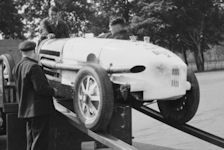
There are more interesting photographs on the national media museum website as well,
like this one of Prince Lobkowicz's Bugatti Type 54 (54201, which failed to be sold
recently at auction in Paris) racing car reversing off a truck, taken by Zoltan Glass
in Berlin, 1932. At the Avus circuit in Berlin he crashed in the first curve, and was
killed, which must have been just days after this picture was taken.
Another one is this of Madame Anne Cecile Rose-Itier (1890-1980) in her Bugatti Type
37
(according to the website) racing car taken also by Zoltan Glass in 1932. The photograph
was taken during a race at Germany's Nurburgring. Mme Rose-Itier began flying aeroplanes
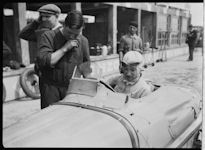 until turning to racing cars in 1926. The car is T37A #37365, which Mme Itier bought to race
until turning to racing cars in 1926. The car is T37A #37365, which Mme Itier bought to race
for the 1931/32 seasons. Being 37A it was a blown car, but distinctive because of its
unusual outside exhaust. It is pictured at the Grosser Preis von Deutchland at the
Nürburgring, racing no. 56. The car still exists and has been seen out regularly. It
is now fitted with a standard exhaust system. Info: Henrik Schou-Nielsen
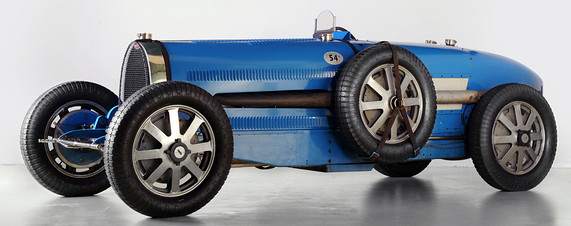
February 7, 2013 Bonhams auction Paris, France
Auction house Bonhams said it will offer a well-known Bugatti Type 54 factory racer at its Feb. 7 sale, which coincides with the weeklong Retromobile collector-car festivities in Paris.
The car was driven by Achille Varzi at Monza in 1931. The event, the IV Gran Premio Di Monza, was the first race for the then-new Type 54s with 4.9-liter, twin overhead cam, supercharged eight-cylinder engines. They generated an amazing 300 horsepower and gave the cars top speeds around 150 mph.
During preliminary heats the Type 54s performed well, with Varzi finishing first and fellow Bugatti driver Louis Chiron in second. In the main race, however, two flat tires slowed Varzi, who finished third. Still, Varzi set the fastest lap time at an average speed of 102 mph.
This car will also participate in the Goodwood Revival meeting, a vintage-racing Sept. 13-15 in Chichester, England.
The auction house estimate is $3.2 to $4.4 million.
The car is 54201, currently owned by Olav Glasius, who also recently sold a large part of his Lotus collection.
This was the first car made with its original smaller brakes. Later cars were converted to the bigger ones. The front axle is the correct hollow type. The engine of this 54201 car has always been stamped 1. All reference to engine 50133 are a Conway error circa 1972. That is all documented in the Hampton diaries on this car. However, in 2000, the UK BOC Register stated "Original engine stamped 50133 or 5013?" with no mention made of engine 1 - another incorrect entry.
After Lobkowitz fatal accident the car was given to his friend Zdenek Pohl together with his type 51 -(now in the Prague museum). Pohl had ordered the second body made by Uhlik in Prague. When Peter Hampton owned the car this body was removed and sold to Ray Jones, who sold it to Skip Berg, USA - who put on a frame by Ray Jones, see # BC 070
A 54201 replica body was made by Peel in 1971. The car had an extensive, and fully detailed, 4000 hour restoration at 4£ an hour! The car 54201 is now in the Netherlands. The Hampton body was not correct as it was made to order for Hampton from his own drawing. A correct body was made by Rod Jolley, maintaining the original hood and windscreen (which is still stamped "Praha", as it was replaced in Prague after the accident.
An interesting portfolio of documents was with this car from Hampton. Including his dairy, Telexs, payments , and even Junek letters including the story of Hampton being chased across Europe by the Czech Police when word got out that the car was leaving without a permit. Hampton demounted the radiator in LeHavre ( he had one hand!) and as soon as he arrived to the UK discarded the Ulhik body to disguise the car. It was at this time that the engine number information was concealed and Conway entered into his ledger with this phony 50133 number. It's all explained in Hampton's dairy. For years Hampton was afraid of the Czech police coming in to take the car away. When purchased in 1991 by Abba Kogan, Lord Raglan hinted that even the frame was replaced but this was not the case. Townsend did the first work on this car, and examined it carefully. It was confirmed that it was frame 3, and original. Pohl exchanged the T54 for a Fiat and a little cash, at a time where Pohl had a 1939 Auto-Union sitting in his garage!

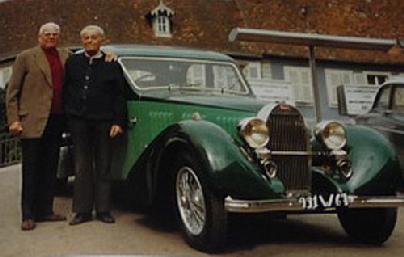


- Lot 169: Bugatti Type 52 'Baby' Châssis No.430A ; Estimate 30.000 - 50.000 euro
These small Bugatti 52s were manufactured by the factory for the use of clients' children. This one was purchased by the father of the present owner in 1947 at an auction in the region of Colmar. He gave us three photographs. The first dates back to the 1950s in which we see the owner at about five years old, at the wheel of this electric sports car, a photograph from the 1970s with the owner's son and a current photo with his little grandson! Touching to see this little car in the family through the years and without any wrinkle whatsoever. It was repainted a few years ago and the engine works very well. A really nice opportunity to evoke the legendary Bugatti Grand Prix for your little ones.
More info at: www.artcurial.com
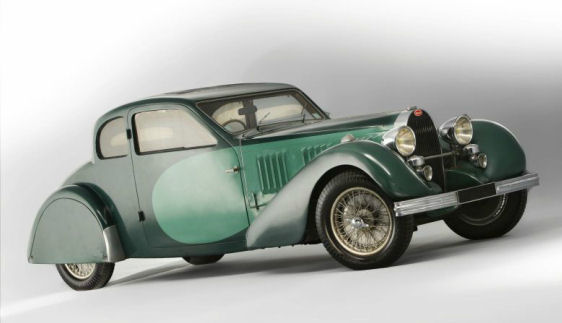
- Lot 364: 1936 BUGATTI 57 C VENTOUX Châssis 57452/57308; Estimate 250.000 - 300.000 euro, no reserve
Carte grise française portant le numéro de châssis : 57557
Chassis : 57452 / 57308
Moteur : 1C
First supercharged 57 C built
THE PARIS MOTOR SHOW, OCTOBER 1936.
The Molsheim factory was buzzing with activity during the last weeks of September 1936. They had to be ready for the forthcoming Motor Show in Paris. The whole Type 57 range was to be there. For the first time, the definitive Sport 57S chassis would be presented to the public, in the form of an incredible roadster and an Atalante coupé. These two cars left the coachbuilder's workshop during the last few days of September and were transported by train to Paris on Monday 28th September. During this last mad week before the Motor Show opened on the first Thursday in October, the workshop worked every day to get a new Atlantic and three Ventoux finished, one of which had an engine to 57S spec with supercharger. The new Atlantic, the third to be built, which was a service car for the factory, also had a supercharger.
The registre des ventes for the factory for September 1936 shows:
On one line : in lead pencil " 57308 Salon 3.10 " and in pen " 57452 1C Coach "
On the next line : in pencil " démonst 3.10 " and in pen " 57453 2SC Aéro "
The registre des carrosseries shows that the prototype 57C and the first 57SC left the coachbuilder's workshop on Saturday 3 October 1936 :
" Coach Ventoux 57/1SC 3/10 57452 rouge cuir havane. " (red with tobacco leather)
" Coupé Aéro 57/2SC 3/10 57453 noir int drap. " (black, fabric interior)
The next day, after some final adjustments, Jules Goux was given the honour of driving the first 57C - the red Ventoux, with engine 1C - to Paris. He was accompanied by Jean Bugatti who took the wheel of the formidable black Atlantic 57SC. The Ventoux was chassis number 57452, and the 57SC coupé was 57453. The two test drivers sped towards the capital on this autumnal Sunday, arriving at the showroom at 46 Avenue Montaigne in the afternoon. The cars were cleaned and prepared as demonstration cars for the week ahead. Clients would discover the power of the two new supercharged 57s, driven by Jean Bugatti and Robert Benoist, director of the Montaigne showroom.
On the 7 and 8 October, a cabriolet, a Gangloff saloon and Jean Bugatti's personal Atalante were driven from Molsheim to Paris to demonstate the whole Type 57 range near the Grand Palais. On a stand, as a static display, a cream and black Gangloff cabriolet and a grey and black Ventoux were on show alongside the two 57S models. There was no 57C on display at the Grand Palais. The Atlantic 57453/ 2 SC and the Ventoux 57452 /1C were used to take privileged clients on test drives, driven by world champion Robert Benoist. Externally, the red Ventoux resembled a standard model but it had a better performance than a non-supercharged 57S model. The ultimate weapon was represented by the black Atlantic 57SC, which kept up with times recorded for the 57G on the Montlhery ring on Saturday 10 October 1936 in the presence of the Parisian press. The new supercharged machine reached speeds of 200km/h according to Ernest Friderich, who was there. The red Ventoux with engine 1C was undoubtedly taken to Montlhery too, although there were no official records for these two factory service cars.
THE 57C DEMONSTRATION CAR
After the motor show in October 1936, the red Ventoux stayed at the Montaigne showroom as a demonstration model. Test drives were given by Robert Benoist and Pierre Veyron. No Bugatti Type 57C was available to buy until February 1937. Engines 2C and 3C, two Gangloff cabriolets, were delivered at the beginning and end of February 1937, to very special clients : Dr Kocher from Valence and Jean Baylet from Toulouse. Production for the new model was slow. Cars with engines 4 and 5 were delivered in March, and those with engines 6,7 and 8, in June. Throughout 1937, the red 57C was driven round Paris by factory test drivers, a showcase for the new 57C series. From Spring 1937, it was registered " châssis 57308 ", and used the registration plates 4834 NV3, (as confirmed in a factory note in April 1937). It wasn't the only car to use this registration. A letter from the repair workshop in Levallois sent to Molsheim on 15 September 1937 notes 3 engine faults caused by seizure or breakage of the 8th piston. One of the cars concerned is the 57C demonstration model.
" 57308/1C- with supercharger. 23.237 km.on the clock. This is the demonstration car from the Montaigne showroom that Keiffer drove to the factory yesterday. We have completely rebuilt the engine after the rod broke. We carried out the usual tests to make the car available again for Montaigne. During the first test drive carried out by the Sales Service, the sound of the engine starting to seize was noticed, and the car was driven back to us at 23,365km As the factory needed the car urgently, we limited ourselves to trying to stop the seizure by injecting oil into the 8th cylinder. The car is now at Molsheim, and therefore available for you to work out the reason for this problem."
On 13 October 1937, 57308/1C was using the new registration 6196 NV3. The papers were assigned to the Toussaint factory conveyor. The vehicle went to Paris as a client had shown an interest in buying a Ventoux 57C model. Production remained slow. Just 5 vehicles were built during 1937. These were 57517/7C, 57506/8C, 57526/ 10C, 57496/11C and 57576/12C, delivered between June and August 1937. No other Ventoux 57C would be built before the end of January 1938. It didn't take long for the young Count Aymar le Larochefoucauld to make up his mind. He had already put his name down for this model in February 1937, but the production programme had been put back, and didn't resume until June.
AYMAR ANTOINE ANNE MARIE DE LA ROCHEFOUCAULD (1914-1991)
He was born in Paris on 7 March 1914. A descendant of one of the oldest families in France, he lost both his parents in 1918. His father was killed on the front line and his mother died of tuberculosis, and he was raised by his maternal grandparents in the château de Douy en Sologne. It appears that he started driving from a very young age. He also took up hunting and became a formidable shot, travelling the world to satisfy this passion. In July 1935, at the age of 21 years, he became the owner of a second-hand 4-door Type 57 model by Vanvooren, chassis 57214. The car cost 30,000ff with the part-exchange of a Type 49 chassis 49399, that belonged to the family. The address given at the time was in Neuilly sur Seine. It is extraordinary to think that A. de La Rochefoucauld was the owner and driver of this 1931 Bugatti, that left the factory when he was just 17 years old. He wasn't the first member of the family to tame thoroughbreds: his uncle Sosthène took part in the first Le Mans 24 Hour race in 1923 at the wheel of a Type 23. He was the director and shareholder of Carrosserie Profilée which was responsible for building the bodies of most of the Parisian Bugatti from 1922 onwards. On 25 June 1942 Aymar married Mlle Claude Normant, originally from Romorantin and heir to a fortune made in the textile industry. There was no time for the Bugatti. The dark clouds didn't clear until the spring of 1944. A son was born, followed by two other children, to the growing family installed in the ancestral château Douy near Chartres. In 1988, a nephew of Aymar's bought a 1935 57 Stelvio at auction, and proudly took it to show his uncle who had recounted tales of Bugatti motor cars to him as a child. No sooner had he arrived at the garages at the château de Douy, than the elderly uncle, now aged 74 years, took to the wheel, rediscovering the driving skills of his youth. Following a lengthy drive around the Sologne region, he wore a smile as he handed back the tamed beast to his nephew. The La Rochefoucauld motto "It's my pleasure", engraved on the family coat of arms for nearly a thousand years has perfect meaning during these rare moments of shared pleasure.
PARISIAN LIFE 1937-1961
The Bugatti 57308C remained in the Paris area, and on 27 April 1955, we find the car registered to Gaston THERET, who lived at 25 Place des Vosges, Paris on 27 April 1955. The registration document records the original number 4420 RL 3 which dates back to the autumn of 1937, when it had been bought by A de La Rochefoucauld.
The address, 25 Place des Vosges was the Parisian headquarters of the " Société Anonyme des Ets Gaston Theret ". This was a foundry and metal business dating from 1818, with factories in Nouzonville and Neufmanil in the Ardennes. After the war, the company took the name " Ets Veuve .G. Theret ", and G. Theret registered the Bugatti 57308C under the number 2496 DX 75 on 27 April 1955. He kept the car until 12 October 1960. It was then sold to Michel GILLET, of 3 rue des Bas Rogers à Suresnes. This was also the address of the Garage de Gaston Garino, Hispano-Suiza and Bugatti specialists.
HOLIDAYS IN BELGIUM 1961-1975
The archives of Belgian importer Jean De Dobbeleer record the purchase of the car from G.Garino in 1961. We have found two snap shots, in the De Dobbeleer photo archives, of the Bugatti 57C when it was imported from France, now in a dark livery. The registration plate 2496 DX 75 is clearly visible. The same year, the car was sold to Georges MARQUET- DELINA in Brussels, owner of a chain of hotels both in Brussels (Les Grands Hôtels Belges SA) and in Madrid (Hôtel Ritz and Palace Hôtel). It appears that he bought 28 Bugatti motor cars from J de Dobbeleer at the start of the 1960s. The cars were kept in different spots around the Belgian capital. A downturn in fortune later that decade forced him to part with his collection and some of the cars were sold by Christie's in March 1973.
Around 1975, the Ventoux 57C 57308, was acquired by an enthusiast from the East of France, Jean Serre de Montbéliard. He owned several cars that had come from the Marquet collection, and so 57308C was garaged alongside a Type 57 Atalante and a Type 35T. It appeared that the 57C hadn't been driven during its stay in Belgium.
In 1975, Serre gave the Ventoux to the workshop in Molsheim run by Lucien Wurmser to be restored.
LUCIEN WURMSER (1907-1987)
This former mechanic for the factory's competition cars, had become an apprentice at the age of 14, in 1921. Returning from his military service, he was transferred to the repair workshop in Levallois during 1929, and subsequently became involved with race car preparation. He was involved in all the major international racing events that Bugatti took part in, and worked on all the different models from the supercharged Type 35 to the 57G. In the autumn of 1975, he undertook his final Bugatti engine re-build, for Mr J. Serre. Wurmser's son, Roland, who had taken over and modernised the workshop in 1973, helped restore the bodywork. He handbuilt an entire new front wing that needed to be replaced. The mechanics also required a great deal of work.
RESTORATION IN MOLSHEIM : AUTUMN 1975 - SUMMER 1977
According to the recollections of Alfred Wurmser " The Ventoux 57C left Molsheim in the summer of 1977, with its original supercharger, original fabric and leather upholstery and front bumpers, consisting of half bumpers. It also had the original dashboard, with levers for advance and hand throttle (on the first supercharged 57 models), two giant Jaeger dials and four smaller instruments situated around the starter key. According to the photos, when the car arrived at the body workshop, it was already in two-tone green livery. "
At this time, the car had already had the chassis number 57557 re-stamped, visible on a photo. Some time between 1977 and 1984 (the date it was sold to the current owner), the car lost its original dashboard, firewall and supercharger. The vehicle was sold at auction on 20 June 1984, at A.C.F. place de la Concorde, by the famous auctioneer Francis Briest, making 318,000FF. It was bought by the current owner, Jean Brignole, who immediately took the car to specialist Novo, for restoration. When the car arrived in his workshop, Jean Novo noticed that the original pinion from the supercharger was still there, which was the last visible sign of the supercharger mounting on the first 57C. He also noted the special dual-disc clutch, reserved for the 57S model. J. Novo, replaced this with the standard version.
In a note from the factory about this vehicle, the term 'Moteur 1SC' is used once. We know that this is incorrect, although the car had certain mechanical features used on the Type 57S. This was, after all, a prototype of a new model, and a contemporary of the first 57SC, for the factory's use.
Following work by the Novo workshop, J. Brignole took his car to Corsica, where it has taken part in several rallies over the last 20 years. J.Novo has been to Corsica every year to maintain the car.
When we inspected the car in Paris in November 2011, we knew that the chassis number (57557) was not the right one for this Ventoux, as the Atalante produced with this number is in the US, with incontestable identity. We needed to find evidence on the car that would allow us to trace its history. The bonnet is stamped 26, indicating that the body was built around September 1936.
The rear axle is stamped with the number 334. The gearbox carries the same number, but it also has " C1 " stamped on the cover. On the left rear side of the engine, the number " 1 " appears in the correct style for the factory. The chassis number reads " 57557 ", but the last three numbers appear to have been added later, and signs of the numbers " 308 " are visible. It is a note from the factory recorded in the engine book that gives us the answer to the mystery: " Moteur 334 devenu 1C " and " 1 - 57452- 57308 - ex moteur 334 ". The first line explains the modification from the 334 engine to a 57C, with engine number 1. The second line confirms information that records the car carrying the chassis plate 57452, then 57308.
We are indeed in the presence of the first Bugatti 57C ever built, the demonstration car for the Montaigne showroom during 1936 - 1937. Jules Goux, Robert Benoist , Pierre Veyron and perhaps Jean Bugatti himself, when he stayed in Paris, would undoubtedly have been the first people to drive this fast, supercharged, red Bugatti.
It won't take much to restore this car with its supercharged engine to its former glory, while retaining its wonderful patina.
Pierre-Yves LAUGIER , December 2012.

- Lot 367: 1935 BUGATTI TYPE 57 CABRIOLET VANVOOREN Chassis : 57274, Moteur : 197; Estimate 650.000 - 1.000.000 euro
The chassis was delivered to MOURRAL on 4 April 1935. The name of the dealer Lamberjack appeared in the register of sales for chassis 57274 - engine 197. The invoice register shows: " 4/4/35 f 57274 MOURRAL Suresnes 45600ff. " The price for the body is not recorded, but we know that body 57269 was invoiced to the factory for the sum of 27,000ff, and the two bodies are almost identical. By comparison, a four-door saloon body was billed at 15,000ff by Vanvooren, and a four-seater cabriolet body by Gangloff cost between 14,000ff and 18,000ff. The high build quality of Vanvooren cabriolets on Type 57 chassis made these cars expensive, in relation to the cost of the bare chassis. To quote a great author " the price is forgotten, the quality remains ". The chassis, ordered by the intermediary Lamberjack, was delivered by train (as shown by the 'f' in the register) to Mourral in Suresnes. The address in Suresnes is actually the SAURER factory. The company " Automobiles Industriels Saurer " was on the site the old Darracq factory at 67 avenue de Verdun, Suresnes.
AUTOMOBILES INDUSTRIELS SAURER.
This French subsidiary bought the Darracq-Serpollet omnibus factory in Suresnes in 1910. It opened a branch and a workshop in Lyon in 1912. In 1956 Saurer sold his lorry factory in France to Unic. Ties between Mourral and the Lamberjack family, the Bugatti dealer in Paris, would have encouraged the regular participation by Dominique Lamberjack Senior in the Paris-Nice Rally, and in the Rallye du Maroc in 1935, in buses nicknamed " Popol " and " Virginie " by Saurer. The Saurer buses were the most luxurious on the market. They performed exceptionally well for vehicles of that period, reaching speeds of more than 100 km/h, and with very efficient brakes. Bugatti was already using a Saurer to get to Le Mans in the 20's!
JEAN EUGENE HENRI ALPHONSE MOURRAL (1888-1972).
He was born in Irigny in Rhône on 14 September 1888. After studying engineering at the Ecole Centrale, he served during the first world war, where he left as a captain. He was made Chevalier de la Légion d'honneur in 1919. Mourral became Director General of Automobiles Saurer, and also had interests in other companies. He rented an apartment in Paris at 29 rue de Sèvres, next to the hotel Lutetia, and had a family home " Le Chevallon " in Voreppe, Isère. The Bugatti was registered at his Paris address in April 1935 with the number 7178 RJ 7.
In 1935, Mourral was 47 years old. According to family recollections, it appears he had no other car. He kept the Bugatti until almost in his 80s. The vehicle had been re-registered in his name and Paris address on 21 March 1955 with the number 7926 DR 75. After more than thirty years of good and loyal service, the Bugatti would be sold to buy a Peugeot 404 ! It had a low mileage, as it had been used very little in Paris. At the occasion of a nephew's baptism in Isère in 1966, Mourral was still driving his faithful Bugatti. On colour slides taken at this event, we see J. Mourral, in his fedora, at the wheel of his precious cabriolet. The car appears to be liveried in black. The spokes of the wheels and the radiator are also the same colour, as was the norm on the Bugatti Type 57 before 1936. The horns are a different model to those fitted later. Five years after selling his cabriolet, Jean Mourral died at his home in Voreppe in 1972.
Several months after it had last been driven, the car was sold, on 16 November 1967. The identity of the buyer, from Vaucluse, is unknown. It was registered with the number 62 LQ 84. A year later, the cabriolet was bought by Pierre VIDALENC from Paris, who registered it with the number 8838 VG 75, on 29 January 1969. This enthusiast carried out a comprehensive restoration of the car. The originally black paintwork was changed to the cream and brown it is today. For more than fifteen years Vidalenc was a regular attender of Club Bugatti events and prestigious rallies such as the Paris-Deauville. He decided to part with his rare Vanvooren cabriolet in 1988.
On 9 November 1988, the car came under Maitre Poulain's hammer at auction, and sold to the current owner, Pierre BRIGNOLE. From that point, it was meticulously maintained by the mechanical workshop Novo. Recently, the paintwork was redone by a specialist workshop in Corsica. The upholstery and front shock absorbers are new.
Examination of the vehicle has shown that hydraulic brakes have been fitted. This modification must correspond to updating work commissioned by Mourral around 1939. The major mechanical components are all original and in excellent condition. The engine is engraved with the numbers 57274 and 197, and this is the first model with rigid fixings and exhaust towards the front. The intake manifold and the Stromberg carburettor conform to the original model. The cam carriers bear the engine number 197. The coachbuilder's plaque " Vanvooren Carrossier Courbevoie Paris " is visible at the bottom of the two front wings. The dashboard has two large dials: a rev counter and a speedometer, positioned either side of the starter key. Two spanners allow adjustment of the shock absorbers. The upholstery is new. The hood allowed for the 'Milord' seating position, the mark of all grand Vanvooren cabriolets. The car doesn't appear to require major work before joining the garages of a new enthusiast, who will have the honour of representing, on the road and in concours d'élégance, the distinction of French coachbuilding from the golden age of the automobile.
This rare and beautiful car has had the good fortune to have been kept vigilantly by its first owner, hidden in Provence during the war, and then used regularly until the mid 1960s by its faithful admirer. More than thirty years of faithful ownership allowed Jean Mourral to bequeath to us a car that retains the mechanics and body in a condition as close to the day it left the factory as is possible to be. Of the four cars of this model bodied by Vanvooren in 1934-1935 to the second design proposed to clients, this cabriolet, 57274, is one of just two that survive.

- Lot 391: 1995 BUGATTI EB 110 SS Châssis n°ZA9CBO2U5RCD39025; Estimate 380.000 - 480.000 euro
- Founder Romano Artioli's personal car from new
- 14 000 km from new
- The last EB 110 SS built
The excitement awaiting enthusiast for the Mondial de l'Automobile in Paris in 1991 was the rebirth of the Bugatti name in the form of an extreme Grand Touring car. Superlatives could be applied to this car for which the highest level of designers such as the legendary Marcello Gandini, engineers such as Paolo Stanzani and prestigious companies in high technology areas such as aerospace company SNECMA came together. The Bugatti EB 110 had as an engine a real piece of jewelry, a compact V12 of just 3.5 liters, but fed by four turbochargers which developed 585bhp, along with all wheel drive. The chassis was made entirely of composite materials and suspensions used technology from aviation. Respecting the traditions of the Bugatti brand, the interior and upholstery were all subject to the greatest care: tightly packed in the finest leather, the dashboard made of the best of precious woods. Its technical characteristics allowed it to claim class-leading performance: a top speed of nearly 350 km/h, 0 to 100 km/h in less than 3.5 seconds and the standing kilometers in under 20 seconds! To this was added four wheel drive which made the car easy to use though with the appropriate driving skills the car was the quickest in the world at its launch.
A few months later, at the Geneva Motor Show of 1992, the new company decided to push the envelope even further! With the main objective of getting the EB 110 into competition, the Campogalliano factory developed very quickly the SS (SuperSport) version for which a number of alterations were made. Now max power stood at 610bhp, and torque increased in the same proportion, and the weight went down - the already impressive performance of the car has improved further. Racing bucket seats made their appearance in the cabin, as well as carbon and aluminum. The atmosphere was downright sporty! In 1995, the "Bugatti Automobili" adventure came to an end. But before that Romano Artioli, its founder, decided to get the factory workers to make his own EB 110 SS, that he would keep in remembrance of Bugatti Automobili. This was the last Super Sport produced, the 31st, and the mechanicals underwent special preparation, which pumped up power from 610 to 650bhp. A great car and an excellent opportunity: in fact, to this day, this car has never been registered and has covered barely 14,000km since it was made. The purchaser of this EB 110 will be the first 'official' owner of the car. Since the collapse of the company, the car has been maintained in an extremely thorough way at the Zagato workshops, where the offices of Romano Artioli is located. As Artioli is creating a brand new car, but in a different style: the Volpe, an electric city car... To raise funding for this project that Ingeniere Artioli is selling his two Bugatti. This Bugatti EB110 SS has it all: the origin, history, technological sophistication, all of which makes this car unique and exclusive. In addition, it will provide its new owner the intoxication of its power and the handling of the ordinary. A unique opportunity indeed.
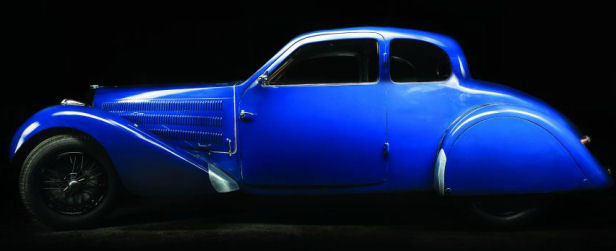
- Lot 392: 1935 BUGATTI TYPE 57 COACH VENTOUX Châssis 57344, Moteur 265; Estimate 280.000 - 360.000 euro
The car left the body shop on 3 February 1936. It was black in colour with a pigskin interior. On 10 February 1936 it was sold to Henri Matile, the Bugatti dealer in Nantes, who had a large showroom in the city at 20 rue Racine. He was invoiced for 57,608 French Francs - the set price charged to all dealers for the new model. Matile had ordered the car at the start of the year, and registered the vehicle on 14 January 1936 (number 8795 JH 3) - two weeks before it left the factory! After two months of use for client demonstrations and on display in the Rue Racine showroom, the car acquired its first private owner on 8 April 1936: Marcel Rineau of 20 rue Franklin, Nantes, an entrepreneur specializing in heating installation. His well-established company installed central heating in such historic buildings as the theatre in Fontenay-le-Comte, in 1924, and is still based in Nantes (at 46 Boulevard de la Prairie-au-Duc) - although it is no longer family-run. Marcel Rineau owned no other Bugatti. The car was badly damaged by an accident near Saintes (Charente Maritime) around 1939, when it went off the road; it may subsequently have been taken back by the dealer Henri Matile. On 17 March 1939 it was registered in the Seine département (Paris area) under number 600 RM 3. Yet by 26 April 1939 the car was again back with Henri Matile, now with the number-plate 2751 JH 5. In August 1939, shortly before the outbreak of World War II (and the very day of Jean Bugatti's accidental death), Matile found a buyer from Toulouse for his former demonstration car. On 11 August 1939 the car was registered with number-plate 9004 FS 5 at the Préfecture de Haute Garonne, in the name of P. Guggenheim of 42 chemin de Payssat, Toulouse. On 11 November 1942 German troops invaded the Unoccupied Zone and, when they reached Toulouse, lost no time in requisitioning the finest homes. But the Bugatti escaped their prying eyes and, on 3 August 1943, was sold to Jean-Maxime Trouvé of 28 rue Peyrolière, Toulouse. He was just an intermediary: on August 6, the car was registered in the name of the Compagnie Industrielle des Produits Agricoles at Salies-du-Salat. The Coach Ventoux stayed there until the end of the war then, on 26 March 1946, was sold to Georges Loubet of Chemin Maubec in St-Martin-du-Touch in the suburbs of Toulouse.
Four months later it found a new owner in Picardy. It made the reverse journey to those fleeing the Nazi advance in 1940, from Toulouse up to Amiens - a city still reeling from the bombings of May 1940. Its new owner was Maurice Pons, Director of an important rubber factory, Les Etablissements Hartley & Pons, based at the Usine de la Croix-Rompue in Amiens with branches in Paris, Nantes and Toulouse. Pons may have come across the car during a trip to one of the branches that had remained operational after the martyrdom of Amiens.
The firm had been founded around 1921, when Pons went into partnership with Captain Harry Hartley, a British soldier (demobilized in August 1919) who had married an Amiens girl in January 1918, then stayed on after the war. Hartley had already been involved in the automobile business before the war, and the new firm specialized in tyres, and in repairing casings and air chambers by vulcanization. Hartley was killed during the 1940 exodus as the Germans advanced into Picardy. After World War II his partner Maurice Pons developed the production of moulded rubber, lodging various patents in the mid-1950s connected to the transportation and protection of bottles and the manufacture of moulded rubber boots.
On 23 July 1946 the Bugatti was registered in the name of Société Hartley & Pons, Amiens, with the number-plate 3886 XP 6. On 16 January 1947 it became the personal property of Pons Maurice, Industriel of 450 route de Paris, Amiens.
One year after reaching Picardy the Bugatti was sold to a Paris connoisseur who had links to the region, as his family had holidayed at Cayeux-sur-Mer, on the Bay of the Somme, since before 1914. On 13 June 1947 the car was registered in the name of Jean Turck of Paris and Cachan. It seems Turck had been driving the car for some time before taking out registration in his own name - as shown by a photograph in his possession, showing it still with a 3886 XP 6 number-plate! In June 1947 the car was issued with the registration number 2482 RP 8 by the Seine département.
The history of this Bugatti led us to track down and talk to Jean Turck, a hearty 101 year-old whose memories of his Bugatti period remain crystal clear. Our recent conversation at his home, and the chance to consult his family souvenirs, revealed an amazing character.
Jean Paul Gustave Turck was born in Paris (3 rue Cler) on 17 May 1911. His father was a skating instructor at the Palais de Glace on the Champs-Elysées. When he was young, Jean Turck developed a keen interest in radio, qualifying as a radio technician at the Conservatoire National des Arts & Métiers in June 1928. He then occupied various jobs in the nascent radio-electricity industry and undertook research into frequency modulation. In 1934/5 he effected his national service at the radio-transmitter station on the Eiffel Tower.
Turck was soon learning about Bugatti mechanics: in 1938 his elder brother André bought a two-seater Type 44 Cabriolet - in which Jean fled Paris with his wife, son and parents when the Germans arrived in June 1940. At the end of the war this 3-litre vehicle was used as a factory car until it was crashed by an employee.
From 1938 Turck worked with engineer Maurice Hurel on plans for a flying bomb, and produced a remote-control system for unmanned aircraft bearing explosives. On 16 August 1943 Turck and Hurel joined the Free France movement and flew out of Cannes from under the Nazis' noses on a prototype plane. Once they had arrived in Philippeville, Turck was contacted by the British and went on to make numerous flights between North Africa and London, perfecting remote-controlled craft and devices for scrambling the guiding systems used by German aircraft aiming to destroy Allied convoys in the Mediterranean. In 1945 the French Naval Ministry (Central Unit for Construction & Arms) asked him to found his own company 'so I could receive orders placed by the Ministry of Defence. After launching this industrial concern my administrator, Monsieur Baconnet, bought me a prestigious automobile: a Bugatti Type 57 Ventoux, which I used to visit clients.'
The factory at Cachan (19 rue de la Gare) was built in 1946 and employed nearly 200 people. In 1948 Turck moved to a new home: Domaine de la Tuilerie at Saulx-les-Chartreux, 20km from Cachan. The property had two large garages for his two Bugattis - the Ventoux was soon joined by a 1939 black 57C Gangloff Cabriolet. A fleet of Citroën front-wheel drive vehicles were needed for all his trips on behalf of the Cachan factory.
'We used to take the buttercup-yellow Bugatti Ventoux for our weekend trips to Cabourg. One day I was mad enough to buy the 57 Cabriolet with compressor from Roger Teillac of Paris (Avenue de Suffren). I think I paid him several million (old) French Francs! The factory garage was run by a remarkable mechanic who had been part of the Le Man 24 Hours from the outset, working for Lorraine-Dietrich, the first winners - so my Bugattis were treated with loving care. But the Coach Ventoux's cable brakes were not the most efficient, so I tracked down a former Bugatti factory mechanic, Albert Divo, who owned a small garage in Paris, at 63 Avenue de Clichy. He fitted an hydraulic system I was perfectly happy with. I used the Bugatti 57C for major trips abroad. I kept both Bugattis for nearly ten years.'
On 4 April 1954 the Coach Ventoux was re-registered in the name of Ets Turck Jean-Paul (139 rue de la Tour, Paris) with number-plate 5379 DU 75. The address was Jean Turck's domicile. In 1949 the Turck firm was contacted by Matra to study ground-to-air missile guiding systems, and became world pioneers in optronics. In 1956 the firm, while remaining an independent entity, became part of the S.A.T. (Société Anonyme de Télécommunication); by now nearly 3,000 employees were involved in the cutting-edge activity pioneered by Jean Turck. Despite his natural modesty, Turck acknowledges that he was ten years ahead of the Americans with his infrared research of the early 1950s. From his retirement in 1976 until 1988 he served NATO in an engineering advisory capacity.
After over ten years of good and faithful service, the Bugattis were sold when Ets Turck were restructured: the Ventoux in April 1957 and the Cabriolet in May 1958.
On 16 April 1957 the Coach was registered in the name of Comte Antoine de Labriffe (1926-95), a 30 year-old banker domiciled at 172 rue de l'Université in Paris - a superb Art Deco building from 1931. He owned various garages for keeping his cars - when they were not at his family estate, the Château de Neuville at Gambais, west of Paris.
In September 1958 garage-owner Gaston Docime, a Bugatti specialist, welcomed his new acquisition to 23 Boulevard de la Saussaie in Neuilly-sur-Seine. Like most of other Bugattis discovered by the bearded Docime, the 57344 would find its way to the U.S. - becoming the property of Hugo Buerger III in Golden, Colorado in September 1958. Buerger worked in the automobile business and was, for a time, a Buick dealer and Jaguar's importer for Colorado. He often travelled to Europe in the 1950s on the look-out for vintage automobiles.
Around 1973 the blue Bugatti Coach was in New York, owned by a certain J. Cappuozzo. The name of Dick Withers also appears before the car was acquired by Ronald Secor of San Dimas, California, who showed it at the Pebble Beach Concours d'Elegance in 1977.
In 1986 the Ventoux Coach was back in Europe, in the hands of British collector H.B. Murphie of Barnston in Cheshire. On 29 June 1992 it was sold at auction by Sotheby's to Romano Artioli, President of Bugatti Automobili SPA - who produced the fast Bugatti EB110 from 1991-95. The car's current owner has had extensive mechanical revision carried out over the last three years at the workshop of Gianni Torelli, one of Italy's top Bugatti specialists.
We would be thrilled to bring together Jean Turck and the next owner of this splendid Bugatti Type 57 Coach. There could be a few revelations about the secrets of its mechanical longevity - though without betraying any Defence secrets!
Pierre-Yves Laugier , January 2013
more info : www.artcurial.com